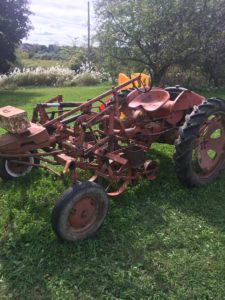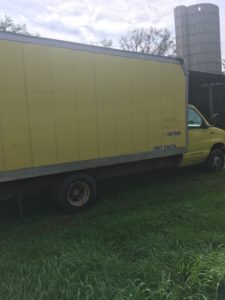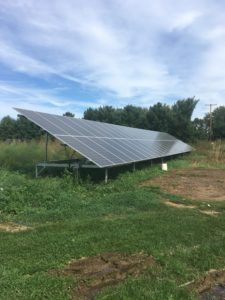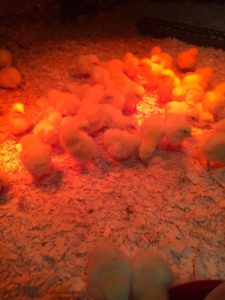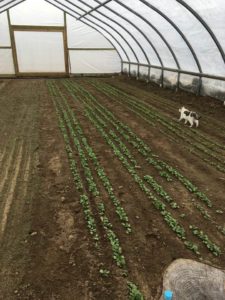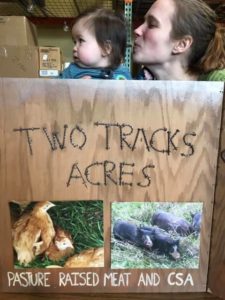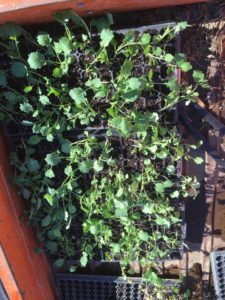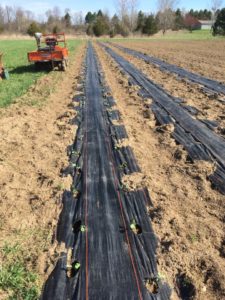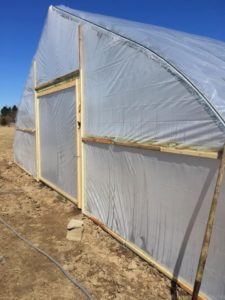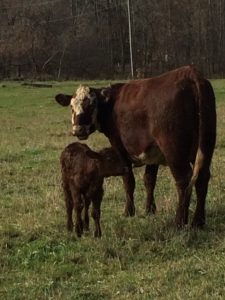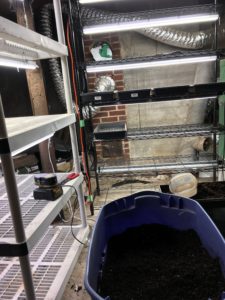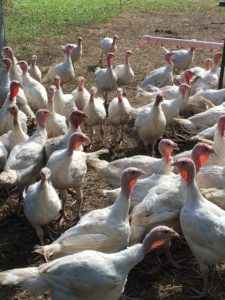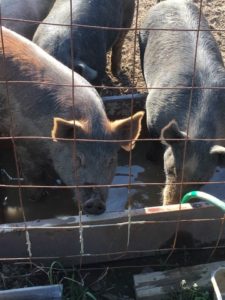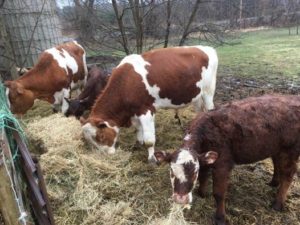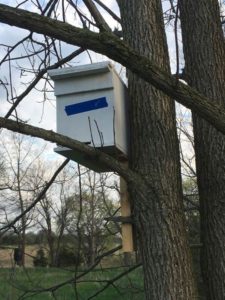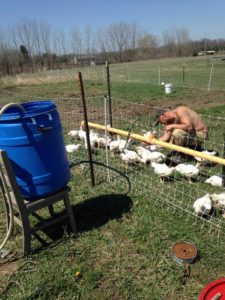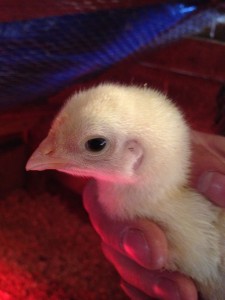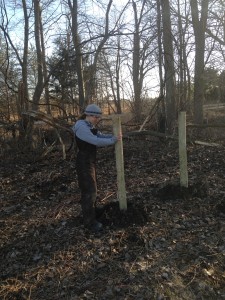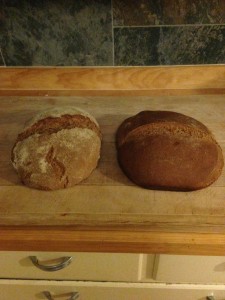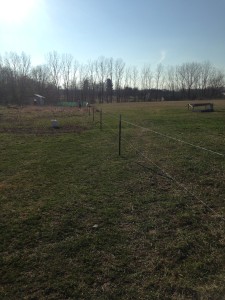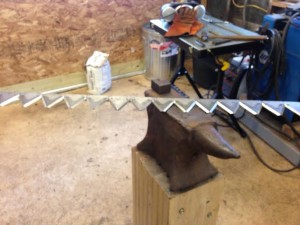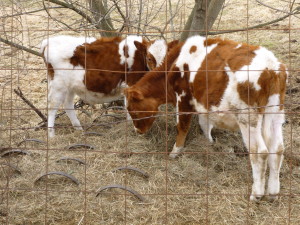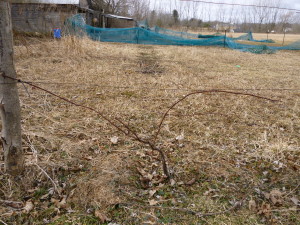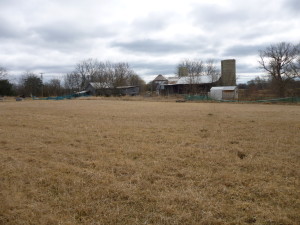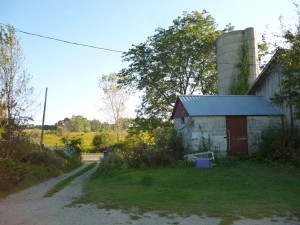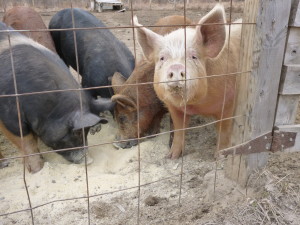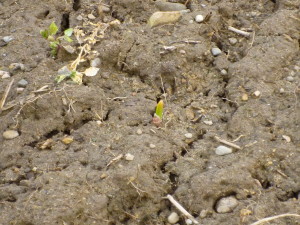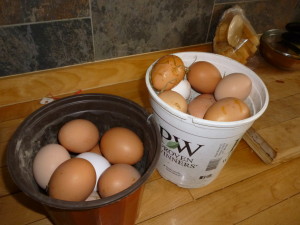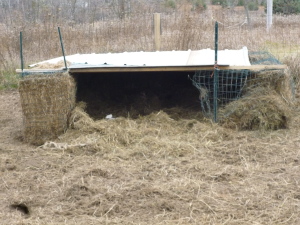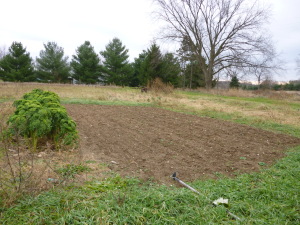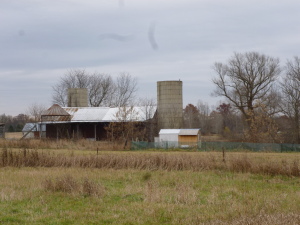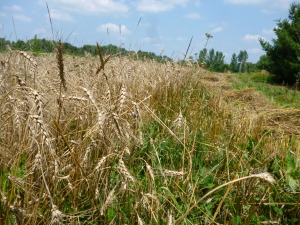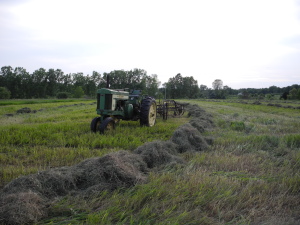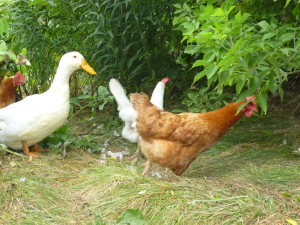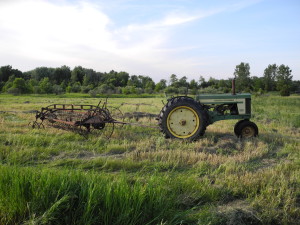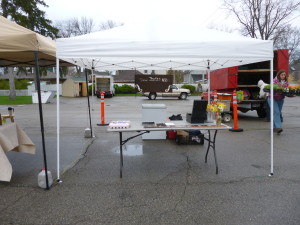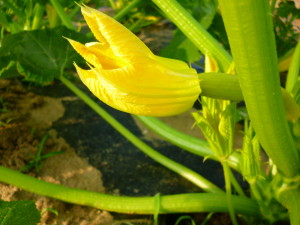When we started our seedlings this spring, we quickly realized that we did not have enough space in our basement, the usual spot. We have an unfinished Michigan basement, and it’s not a problem to get water and dirt all over the floor. However, we have always struggled with our plant starts – they are too leggy, and don’t seem to like it down there (honestly, who can blame them?)
(seedling racks)
A friend and longtime farmer herself lent us some startup funds to get the setup we need: several bakers racks with double lights hanging above each shelf, to provide enough room and steady light for the array of plant starts we have begun. It is a great feeling to get a new piece of infrastructure that has been previously cobbled together, that then makes a big difference in production. I felt the same way about the walk-in cooler (instead of a refrigerator), and the wash pack (instead of the kitchen sink). Like pieces of a larger puzzle finally coming together, these things allow us to work more seamlessly toward our goal to grow a lot of stuff.
(Taik and Lucy on a farm walkabout)
The hoophouses are fully planted, and we are harvesting chard, green onions and kale that I planted last September and then overwintered. The lettuce, bok choi, radishes and greens mixes that we started this spring are also ready. And still we mutter, “We need more hoops,” since it feels like we never have enough spring veggies, even with four houses in production. I’ve come to love and rely on what we grow in the early spring the most, even more than summer and fall. There is the excitement of a new season, of course, but also that spirit of competition as we race to be the first to market with this or that.
(hoop in early March)
As soon as the temps get above freezing, we go from zero to one hundred almost overnight. Suddenly we are planting outdoors, laying irrigation and drip tape, covering beds with insect netting, raking hay off the strawberries, fertilizing, mulching, tilling, starting warm weather seedlings, and all the other odds and ends jobs that need to be done around here. After our long hibernation it’s a relief to be busy again. However, old Jack Frost can be tricky and we have some 25 degree nights coming up, so many things outdoors may not make it. But that’s farming for you, we’ll just have to wait and cross our fingers.
Until next time, be well!
We have pork available! It’s been a long time coming because we ran out super early last year, but we now have lots of yummy things to buy. Here’s how:
- Come visit us at Ann Arbor Farmers Market, Saturdays 8 am – 2 pm
- Send us an email at twotracksacres@gmail.com and come pick up at the farm. We are here most days, so just let us know what you would like and when you can make it. Pay when you arrive via credit card or cash
- Find some of our products (though not all) at Agricole in Chelsea
Bacon, $10, 0.7-1 lb packages
Better than Bacon, $10, 0.7-1 lb packages (tastes like bacon, but cut from the shoulder so it’s more lean)
Chorizo, $10, bulk 1 lb packages
Italian Sausage, $10, links 1 lb packages (5 links per package)
Polish Sausage, $10, links 1 lb packages (5 links per package)
Breakfast Sausage, $10, links 1 lb packages (10 links per package)
Smoked Ham Hocks, $10/lb, range from 1.5-3 lbs
Double Thick Pork Chops, $16, 2 per package bone in, 1.5-2 lb packages
Fresh Ground, $8, bulk 1 lb packages
Ribs, $16, roughly 2 lbs each
Farm updates
Well, the plan to grow greens the whole winter was an epic fail. Although we were able to get good extension on the season through December, there was nothing to harvest in the hoops in the deep winter. Part of the reason might be because we don’t heat them. We expect things will be growing again and ready for harvest by April. Lots of lettuce, kale, chard, salad mix, green onions and pac choi coming our way. I’ve already started seedlings for the spring and hope to plant by early March.
Bagels and shoots have really saved our butts this winter. Since we didn’t have anything growing outside, we relied on baking and pea & sunflower shoots in the basement to get us through the long cold winter months. You can find us every Saturday at the Ann Arbor Farmers Market if you’d like to try one of our yummy everything bagels, or some pea shoots. Every Friday my kitchen steams up from boiling the dough before I throw them in the oven. I even leave the windows open to let some of the heat out, it gets so warm!
Lucky for us we ordered seeds in November. For some reason, this year seed companies seem to be running out really early. I looked at Johnny’s catalog recently and everything was out of stock. Another big difference we have seen from Covid is a backlog at the processing plants where we get our meat processed. Farmers are having to schedule over a year in advance in some places to get an appointment. I think this began when some of the bigger processing facilities shut down, so more people were using the smaller places that we tend to use. It’s just snowballed from there and has now caused a real problem with meat producers all across the country. Fortunately, we were able to get the appointments we needed and still have meat this spring.
As we’ve grown, our vision for the farm has changed. What began with 3 pigs and 20 chickens, has now evolved to include vegetables, shoots, cut flowers, turkeys, pigs, chickens, and bagels. It was last summer that we took a step back and realized we need to cut back and focus, or we are going to spread ourselves too thin. What does this mean? We are taking a big leap and cutting out meat. It was a hard decision – many of you know us for our meat which is what we started with ten years ago. However, we feel that this is the best route for us going forward. If you would like suggestions on where to find pork, chicken, and turkeys, please email me! I know lots of fantastic farmers that I would love to put you in touch with.
That’s all for now. As always, thank you for all your love and support. Be well!
This year 2020, we were lucky to receive the Selma Impact Grant to improve our farm. We decided to invest in perennials- strawberries, raspberries, dahlias, chestnut trees, pawpaws and peonies- part of the long-term vision for our business. One of the requirements of the grant was education, and we promised to conduct on farm tours and blog about the crops we planted. With COVID, no on farm visits took place. However, the following is a summary of what we planted, and some of what we learned.
We are beginning farmers, and there is so much we don’t know. Therefore, I think this information would be much more useful with input from others who may have more experience or discovered other methods for managing these crops. We invite you to share your own suggestions, which we will add to this as a living document when we receive comments. If you have something to add, please email twotracksacres@gmail.com and I will post. Thank you!
STRAWBERRIES
Strawberries, like other perennials, are hard to grow organically because of the weed pressure. That was what I was most worried about for all our crops.
Our first step was to choose a variety. Did we want June Bearing or Day Neutrals? June Bearing, as the name suggests, bear fruit heavily during a short period of time, maybe a few weeks, and then peter out. Day Neutrals will bear fruit all summer, but not as much all at once. For us, it came down to market strategy. We prefer to bring a large amount of a particular product on any given day, to “pile it high and watch it fly” off the table. Also, we thought about time and labor. It made more sense to concentrate on the strawberry picking during a short strawberry season, than to harvest a few quarts every single time we went to market. Harvesting small quantities of anything is not time efficient because each item requires its own unique picking, washing and storage.
However, Day Neutrals were tempting because they can bear fruit in the first year, and do not need to form a large matte with runners before harvest. This makes them easier to weed – they can be grown as an annual and the weeds don’t have the chance to get established.
We purchased 1,000 berry plants of the variety Jewel from Nourse Farms, a June Bearing strawberry with excellent flavor as well as large berries, easier for picking. Nourse Farms was recommended to us as a reliable source with good stock.
Next, it was time to plant. They arrived and we planted in May. Strawberries are shipped with long roots already and a crown with a few leaves. We dug long trenches through the field with our tractor and spread the roots out in the trench. (Ideally, the hole would be deep enough that the roots could stretch straight down, but we didn’t do that). I then went through and covered them with dirt by hand, leaving the crown just above the dirt. We ran drip tape down each row so that we could water if needed (a sprinkler is another option) and we waited for them to grow.
The plants grew and even produced a few berries, though year two will be when we see high yields. A person can pinch off the flowers and extra runners to encourage larger berries the following year, though we didn’t do this. As expected, the weeds grew too. Since strawberries form a thick matte, it’s not possible to cultivate with a tractor long after they are in the ground. We went through and hand weeded one time, though it was not realistic to weed once the season got under way. As a result, they were pretty weedy by fall, but the plants themselves looked healthy. A trick we learned was that as they set out runners, it’s good to push the runners into the planting rows, to leave a clear walkway for picking.
Another problem was the dear. They ate the plants and stunted growth. We sprayed a mixture of egg and water on the leaves, which the dear don’t like. It helped a little, but not a lot. Next year we may put an electric fence around them.
Strawberries should be mulched in the fall/winter to protect them from the worst of the cold. We bought weed free straw from a neighbor and spread it in November. This was a little early, as you should wait until they are dormant or there have been 6-10 hard frosts. However, I was worried about the dear, so mulching prevented further damage from them.
Helpful resources:
https://www.noursefarms.com/growing-corner/planting-guide/
Questions for other growers:
How do you manage weeds? Have you had trouble with pests or disease in growing strawberries? How long do your beds last, or when do you plant new berries? Do have a dear management plan?
RASPBERRIES
With raspberries we had another choice to make. Did we want summer bearing or everbearing? Summer bearing varieties “carry one crop of berries on the over-wintering canes during the summer months. Plants begin fruiting in early summer, and the season lasts approximately 4-5 weeks.” (Nourse Farms guide). Everbearing varieties “produce two crops: the largest is borne in the late summer/early fall on the tips of canes that grew throughout the summer. A second crop is then carried lower on those same canes early the next summer. To have two crops, the planting must be pruned as a summer bearer.” (Nourse Farms guide).
We ordered 200 raspberries of the Caroline variety, again from Nourse Farms. These everbearing plants have excellent flavor and produce large berries. The canes need to be trellised so next year we will use fence posts and string wire in order to keep them off the ground.
We didn’t do much this first year with these plants. This fall we mulched them for winter and weeds. Growing guides warn not to leave raspberries mulched long past the first year or diseases may develop. It’s better to hand weed (if possible).
Helpful resources:
https://www.noursefarms.com/growing-corner/planting-guide/
DAHLIAS
Dahlias are beautiful and can form large flowers, something attractive to me as making bouquets is very time consuming. I also like the idea of being able to save our tubers and replant next year. We had mixed results with our first year growing these.
We purchased 100 dahlia tubers from Fred Gloekner and planted some in the hoop house, some in the field. I made the mistake of planting the field ones in a spot that was too shady, and we didn’t get any production out of the ones that were too close to the trees. A few of the plants that got more sun did produce some limited flowers. I think that they would have done better if the weeds had been better managed.
This fall we dug the tubers not long after the first frost. Doing research, there are so many different suggestions for how to store dahlias over winter, and I am really curious what other folks have found successful. The overall idea is that you don’t want them to be too wet and get moldy, or to dry out either. I wrapped them in wet paper towel and stored them in plastic bags in the basement, where its dark and the temperature won’t vary much. Time will tell if this worked or not.
Next year we plan to do a few things differently. They will go in rows in the field like our other crops, where we can use the tractor to cultivate the weeds until they get too tall. Since they bloom in the fall and die with the first frost, I also wonder if putting temporary hoops and plastic over them to extend the season would be worth it.
Questions for other growers: How do you store dahlias over winter? Do you grow in the field or hoop, and why? Do you use a support system to keep them from falling over?
CHESTNUTS
Chestnuts are interesting because they are delicious of course, but also potential income for the off season – something I am always searching for. We had to decide if we wanted Chinese or European varieties. I’ve read that mixing the varieties can cause the trees to produce split nuts, so we went with a number of different European chestnut trees from Burnt Ridge Nursery. Forest Keeling Nursery is another great resource for trees.
If grown from a seedling, chestnuts can take about eight years to start producing, but ours were grafted, so hopefully they will start producing nuts in 3-4 years. Chestnuts are wind pollinated, rather than pollinated by bees, so we had to be careful to place the pollen producers to the west of the trees that can only receive, and do not produce, the pollen that fertilizes the chestnut flowers. The wind always comes from the west, so we tried to be careful when planning our placement.
For irrigation we buried a water line and inserted an emitter at each tree. We also placed ground cover around each tree for weed suppression. Then we added a white tree guard around the base of the trees – a plastic wrap that stops damage from tiny animals like rabbits. Finally, we placed rings of fencing around them for deer protection.
There are a number of insect and fungus threats to chestnut trees, and this page from MSU’s site gives a good summary of how to identify them and treat them if necessary. https://www.canr.msu.edu/chestnuts/pest_management/
Common insects include potato leafhopper, mites, foliar feeders, rose chafer and Japanese beetle. Trunks should be scanned for signs of chestnut blight and sunscald (or southwest disease).
In a few years we’ll have to start thinking about harvest and storage. Since we have a relatively small number of trees, we can use a small hand tool to pick the nuts off the ground. Nuts must be harvested withing 48 hours of dropping and immediately placed in the cooler.
MSU has a strong chestnut program and our farm is very close to Roger’s Reserve, MSU’s research center for chestnuts. I got to tour it a few years ago and see the giant machinery that breaks down and sorts unprocessed nuts into the more manageable brown nuts we are used to roasting around the holidays. There were large storage facilities, and even information on postharvest treatment and storage to preserve the nuts. Michigan is also home to a large MI Nut Growers Association with an annual conference and lots of information and support.
Helpful resources:
https://www.canr.msu.edu/chestnuts/index
http://www.chestnutgrowersinc.com/index.shtml
PAWPAWS
Native to Michigan, pawpaws are a fruit you simply must try. They remind me of a cross between a banana and a mango in how they taste.
Since they are native, pawpaws are not particularly susceptible to pests or disease. Their big downside is that they don’t last long once they’re harvested, maybe a week at most, and many varieties aren’t truly ripe until they fall on the ground. For this reason, we were advised to plant several varieties that ripen at different times and only plant what we can sell at the farmers market in a week or two. Also it was recommended we get grafted pawpaws, as they bear fruit sooner. A non-grafted pawpaw won’t bear any significant fruit for 7-10 years in many cases. ‘Sunflower,’ ‘Mango,’ and ‘KSU Atwood’ are some preferred varieties. We ordered our trees from Burnt Ridge Nursery, but only got 5 since it’s a bit of an experiment.
Pawpaws are native under-story trees and direct sunlight in the first couple of years after planting stresses them out really badly. A translucent shade cloth can be placed over the young trees for the first year or two that they’re in the ground to help with this. Lastly, trees should be planted all together in a grove as opposed to dotting them around your property. Pawpaws can often struggle to pollinate properly, so having them all together maximizes the chances that the flies that pollinate their flowers will visit adjacent trees at the correct time.
PEONIES
Peonies are those big beautiful pink, white, yellow or red flowers that show up for a few weeks in the spring. I love their fullness and delicate colors, and the stunning bouquets you can create. We ordered 50 plants from Vandeberg Bulb Company for our farm.
Peonies like full sun and sandy soil. There are two groups – herbaceous and tree peonies, but the former is most commonly grown in gardens. It can take 2 to 3 years before you can harvest the blooms. We also got the double flowered types that sometimes need extra staking because the blooms are so large. Plants may live to be over 100 years old, and can be divided to make new plants once mature (after 8-10 years).
Bushes should be at least 3 feet apart, and we planted them in rows wide enough that I can get a lawn mower through. The area is large enough that we intend to use grass and mowing to manage weeds as opposed to bare dirt.
The most problematic disease for peonies is botrytis, which causes blackened burned looking leaves, and sometimes rotting at the base. It usually occurs during damp weather and good airflow can help prevent this problem. Healthy plants are less susceptible, so it’s good to be careful when planting that you give them a good start. We added compost at the time of planting for extra nutrients.
Peonies have a long vase life, and if wrapped they can be stored in the cooler for several weeks and still bloom once removed. It’s best to pick at the stage when a bud looks like a marshmallow.
I won’t know for a few years how successful our planting has been. My challenge will be to keep the area mowed and plants happy until we can harvest.
THE END
Thanks to all our customers and friends for all your support! We couldn’t do it without you. Thanks to SELMA for giving us the opportunity to improve our farm and explore new varieties of perennials.
We have turkeys available! They come fresh, not frozen. Pickup will be on our farm in Grass Lake the Wednesday before Thanksgiving (Nov 25, 2020) fro 5-8 pm. We estimate birds will weigh between 11 and 25 lbs. There is NO GUARANTEE on a turkey weight – it’s impossible to tell ahead of time the exact poundage. Birds are $4.50/lb, dressed, giblets and neck included. They are pastured, free range, Broad Breasted White birds, fed farm scraps and supplemented with conventional feed corn and soy. No hormones or antibiotics. Please order your turkey by emailing us to officially reserve a bird, and include your size preference if you have one. You will receive a confirmation email with further details about pickup.
What a whirlwind this year has been. What an interesting time to decide to quit my day job and go all in with the farm full time. But I can say – surprisingly – so far, so good. We experienced an outpouring of support for local farms and local food when Covid hit and we are so grateful to our customers for really coming through for us! There was a moment of panic when farmers markets closed or delayed their opening dates. Like many other farms, we scrambled this spring to bring our products and sales online, since markets are our primary sales outlet. Other organizations stepped up to fill the gap. Agricole and Argus, hybrid grocery stores that carry only local goods, started selling more and also increased their online sales. White Lotus, Tantre and many others worked to aggregate products and bring food from several farms together to offer customers a wide range. The way our local food system works, and how we distribute food, somehow changed almost overnight. Who knows which changes will stick around for good.
The big-ticket items this year have been our tractors. Up until now, we had borrowed all our big equipment from our friend Ben, who lets several neighboring farms in the area use his tractors (yes, he is awesome). We all take turns. While this is super generous and a great resource, it got frustrating when everyone needed to till and plant at the same time. So, we invested in 2 Allis Chalmer G’s and one Kabota with a bucket loader for ourselves. They have made all the difference, since we can do things on a much larger scale now.
Two interns from Kalamazoo College stayed with us for a month this spring. This was part of an externship program through the college, where current students go to live and work with alumni so they can get hands-on experience in various fields. I don’t know if we convinced either of them that full time farming is the way to go, but we had a blast and they both plan to study food systems further.
For the first time ever we are trying to grow greens through the winter. We have two 100-foot-long hoophouses (unheated) and lots of hearty winter crops out in the field. We plan to use remay (a light blanket that stretches over the rows) to cover the crops and provide additional protection from the cold. Of course, I stated all my plantings for fall/winter a bit late and now all I can do is hope they hurry up and get big, quickly! In Michigan, crops will stop growing after mid-November no matter how warm it is, because there is not enough sunlight. We’ve planted spinach, chard, green onions, kale, pac choi, spicy salad mix, and lettuce. So, grow veggies grow!
For those of you wondering about pork, we will have some in January. Our pigs are still little and won’t be ready until then, but we are looking forward to more bacon to get us through those cold dark winter months. You can order any of our products and pick up on farm, anytime of year, by calling (616) 734-9123. Or find us at Chelsea Farmers Market, Howell Farmers Market, Ann Arbor Farmers Market, and Agricole.
We’ve been busy bees this winter. Here are some of the highlights:
We’ve made the difficult decision not to offer a CSA this year. It was a great run of 8 years, but when we calculated the time it takes for delivery and coordination of all our drop off sites, we decided to simplify and offer our customers the option to buy from us at market or on the farm. We will miss having many of you as members, but we hope you still visit us.
This year you may find us at the following farmers markets: Chelsea, Howell, and Ann Arbor. If we have enough, our products will also be in Agricole.
I quit my job, yikes!! Well, almost, we still have to find my replacement but this summer both Taik and I will be working FULL TIME ON THE FARM. It is so scary yet has so much potential to be incredibly rewarding. It’s always been our goal to make a living from our farm, so this is our chance to go for it. Full disclosure, I am most nervous about the money, the insurance, the savings and retirement, and learning how to work full time together. Don’t get me wrong, we get along great, but even the best relationships can be strained when under this much pressure, spending this much time together. But I’m game if he is. And we are.
No more beef. We are shifting focus to more vegetables and cut flowers. We still have pork, chicken and turkeys. It’s sayonara cows. (Actually, we found them a really good home with Baseline Farm, and a bunch of other happy, pastured cow friends.)
How to make money in the winter? Farming is such a seasonal thing, we need to figure out how to have income during ALL months of the year. So we added two big hoop houses and will be trying our hand at growing winter greens and storage vegetables. Here are some photos of us putting up the hoophouses – it took us 7 months to complete!
We received a SELMA grant to plant more perennials: raspberries, paw paws, dahlias, peonies, chestnuts or apples, and strawberries. As part of the grant we agreed to blog about it and offer 2 on farm field days to share what we’ve learned. We will be working with MSU extension to explore best practices for organic methods of weed, fungus, and pest control. You are all invited to come for a walkabout and talk about ideas for growing these things. We’ll be sending an invite later in the season.
The seeds are started in the basement. We’ve already run out of room and they’ve spilled over into the insulated veggie cooler, which is warm this time of year with a grow light. Once it warms up a little more, we’ll be able to put them in the small hoop. Started are snapdragons, stock, tomatoes, peppers, sweet peas, eggplant, herbs, kale, pac choi, chard, rhubarb, and lettuce.
Here we go!
I firmly believe that its never too early to start thinking about Thanksgiving. We have turkeys available! They are the broad breasted white variety, pasture raised (though we supplement with conventional feed). Sizes range roughly 11-22 lbs, and they are $4.50 a pound. Pickup is on farm the Tuesday before Thanksgiving, 5 pm – 8 pm. Reserve a bird by emailing us at twotracksacres@gmail.com. You can request a size, though we make no guarantees because it’s impossible to tell how big they will be.
Now we’ve gotten the really important stuff out of the way (aka dinner plans), I’d love to share more about what we’ve been up to.
What a year! We are taking this opportunity to invest heavily in our farm and our infrastructure. So next year, look out! Here are some of the highlights.
We bought 2 tractors, Allis Chalmer G’s to be exact. They came as a pair, one for planting and one for cultivating. These tractors were built in the 40’s and 50’s as an extremely light and simple model specifically for diverse vegetable production. What makes them super special is that you can see the ground and as you go over the bed – there’s no bulk in the way. Very few were produced, as they discontinued production when the use of herbicides and industrial ag became more widespread.
We also bought 2 more hoops houses, 100 feet long each. I plan to grow flowers in one, and early spring and late fall greens in the other. Thanks to J & T Todosciuk Farms to selling us their hoops. Buying used hoop houses means you have to do the work of taking them down and putting them up yourself, but used = affordable for this small farm.
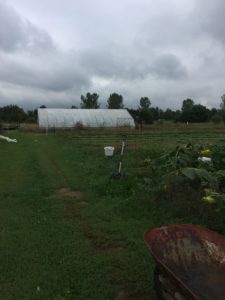 (The new ones will go right in front of this one, so they are all in a row).
(The new ones will go right in front of this one, so they are all in a row).
A truck! Our pickup just didn’t have enough room to haul everything, so we got a big box truck. Thanks to Dwight Carpenter from Carpenter’s Greenhouses. As he is downsizing, we are upsizing and ready to bring more to market.
Our farm and house are entirely powered by solar energy! Thanks to a REAP grant, net metering and tax credits, we installed a very large system that powers everything – irrigation, nursery lights, cooler, freezers, heat and the house. As we expand, our energy needs are increasing, so this was a worthwhile investment and should pay for itself within 7-8 years. Go green!
A lawnmower, cherry peach and chestnut trees, and some peonies round out our collection of new items this year. I already can’t wait for the spring.
While taking such big steps is exciting, we can’t help but be nervous too. There’s always the lingering question in the back of our minds, What if we fail? What if we get too much in debt and can’t pay the bills? We’ll continue to work hard and creatively to try and make this a success. But thanks to all of you for your support, we couldn’t do it without you!
It’s not too late to sign up for a CSA share. Choose pork and/or chicken and receive shares June – October. Visit our CSA page for sign up and info. CSA begins the first week of June.
Farming for us has become more of a family endeavor. My parents recently moved nearby and they have been very helpful in planting potatoes and transplanting strawberries this spring. It’s all hands on deck when that temperature breaks and the nights get above freezing. I’m not sure what their expectations were but I think they were surprised at simply how long it takes to get each crop in the ground. Planting and covering 750 pounds of potatoes took most of the day, but by golly we got it done! It’s nice to have the extra help and share what’s important to us with the people close to us.
Lucy has proven to be a trooper out in the field. The first time she sat in the grass she was not convinced it was a good thing. She is used to the indoors after a Michigan winter and started to whine when her feet touched the dirt. It had me worried, but now she sits happily on a blanket watching Taik and I plant and weed.
We’ve got lots of things growing and will have sunflower and pea shoots, spicy salad mix, lettuce mix, radishes, tulips, and all our pork products for the first markets. Come visit us at Chelsea Farmers Market, Northville Market and Howell Market, starting this week! We’ll have chicken by the end of the month too. Chelsea Market is in it’s new beautiful location, and (drumroll) the Roaming Goat will be bringing breakfast burritos made with Two Tracks chorizo to Chelsea Market, so come get your breakfast on.
Check out these pics from spring here at Two Tracks Acres.
(at the chelsea CSA fair)
(broccoli starts)
(broccoli in plastic for weed control)
(finally put up endwalls for hoop 2)
That’s it for now, happy spring!
It’s CSA time! If you would like to join our meat CSA, please visit our CSA page and return an application with payment by June. Sadly we will not be doing beef this year. We do have cattle, but it takes two years for them to mature and they are still too little. However, we have pork and chicken for y’all.
It may not seem like the time, but we are in spring mode already. Seeds are ordered and waiting patiently to be planted in trays. We sprung for some cherry, peach and chestnut trees. Even though we won’t see any results for years, it will be worth it in the long run. Add that to doubling our asparagus patch, one of the first crops of the season and my favorite, and I have a lot to look forward to.
I am figuring out how to be a mom with a full-time job and a farm. I’ve gotten lots of tips from old time farmers who went through it – pull the baby along the rows in a crate. Set her at the edge of the field in the shade in the pack and play. Wear her on your back in the sling. Last summer I was only able to do the stand up jobs, ones where I could wear her in a pouch and didn’t have to bend over. Lucky for us we have grandparents nearby in a pinch.
Each year our farm business grows a little bit more, and we’ve taken out a loan to invest in some heavy infrastructure. We’ll be adding a pole barn and solar power. The solar just makes sense, because we use so much electricity for our cooler, nursery lights, and many freezers. Plus, there are government grants for farms to install solar energy. Homeland Solar will be installing some BIG panels for us this spring.
We will be doing Chelsea and Howell Farmers Markets this summer. We also hope to get into Northville. No more Grass Lake or Dixboro Markets. It was a hard decision, but we need to be more strategic and consolidate our time and resources.
It’s our biggest growing year yet, with beef, chickens, turkeys, pork, all kinds of vegetables, and a cut flower garden. I don’t know how we will do all that, but we’re gonna try.
TWO TRACKS ACRES NEWSLETTER – March 2018
Baby Calves
Our littlest calves got sick over the winter. It was a combination of not getting enough milk (colostrum) before being separated from their mama, an allergic reaction to the formula we were feeding them, and dehydration from diarrhea. I flipped out and called the vet immediately. We isolated them in the barn and gave them a special diet of sweet treats, high quality hay, and medicine. It was amazing – within a few days they were eating more and began to gain weight. Now they are fat and happy calves! With the warm weather we’ve let them out to mingle with the other cattle and they are happy to be outside. 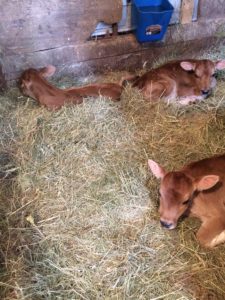
New Year, New Plans
It’s a new year and we have ambitious plans. We will be doing more of the usual – beef, pork, chicken and turkeys. Right now we have 6 cattle, 6 pigs, and plan to get 100 chickens for our first round of fowl. On top of that, we will be raising a wide variety of vegetables to bring to market. Finally, a first – I am trying to grow cut flowers this season. We will see how this experiment shakes out.
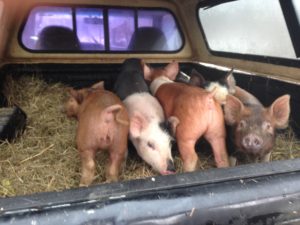
Markets and CSA
Beginning in May we will be going to Chelsea Market (Saturdays), Dixboro Market (Friday evenings), and Howell Market (Sundays). My parents, who just moved three miles away, will be going to Grass Lake Market for us on Wednesday evenings. It will be our busiest year yet! We are also looking for CSA members! The CSA runs June – November with your choice of chicken, pork, and/or beef. Sign up now or see our website for more details.
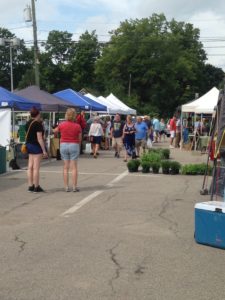
Our Growing Farm Farmily
Taik and I are eagerly anticipating the newest addition to our farm family, a little baby of our own. I am due in August and getting rounder every day. I am hoping our experience dealing with poop and messes will come in handy in this new adventure. No idea yet if it is a boy or a girl, but we are thrilled! 
TWO TRACKS ACRES NEWSLETTER – September 2017
Thanksgiving is not as far away as you think it is! We have Thanksgiving turkeys for sale. They are the broad breasted bronze variety, and ar $4.50/lb. They will be fresh not frozen, with pickup on farm the Tuesday before Thanksgiving. Email us if you would like to reserve a big, beautiful bird.
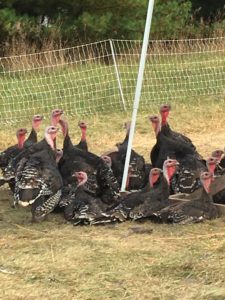 One of the things I find the hardest about growing as a business is balancing supply and demand. This year was a real struggle. By now we have been doing markets long enough that we have a good regular following, and we also added Dixboro Market this season. We raised the same amount of pigs this year, and ran out of pork months early! We also tried to do more vegetables, but didn’t have enough to make up the difference. For next year, we plan to raise a whole lot more meat and grow a whole lot more vegetables.
One of the things I find the hardest about growing as a business is balancing supply and demand. This year was a real struggle. By now we have been doing markets long enough that we have a good regular following, and we also added Dixboro Market this season. We raised the same amount of pigs this year, and ran out of pork months early! We also tried to do more vegetables, but didn’t have enough to make up the difference. For next year, we plan to raise a whole lot more meat and grow a whole lot more vegetables.

We decided to transfer another acre from hay to vegetable and fruit production. To prepare the field for planting next summer, we plowed, tilled, raked and planted a rye cover crop to prep the soil. As always, I wanted to do it the hard way and began raking the quack grass out with my hand rake. Taik came along on the tractor pulling the old hay rake, a relic from the 30’s we inherited when we bought the farm, and swept it all into piles quick as a wink. Our soil is very sandy, so I am hoping the cover crop will add some biomass. We also mucked out the barn and spread manure over the field, but it didn’t cover very much ground. The turkeys have been rotated over that section at least once, so we are trying a number of ways to add nutrients. In the wise words of Elliot Coleman, feed the soil, not the plants (yes I am paraphrasing, but you get the idea). It will still take years to get the soil where I want it.

Now that its fall the weeds are starting to go to seed with a vengeance. It’s tempting to leave them in the field and let the frost kill them, but then all of those seeds will come up next year. Every time I look at a weed, I see it multiply by 100, and imagine myself digging them up next summer. So, I have been making sure to clear them all out.
A big project this summer was redoing the siding on our house. The paint was old and peeling. We decided to strip all the boards off, plain them, flip them over, and put them back up in the same order. It was a lot of work, but well worth it! It was fascinating to get a close look at this old wood siding, oak, and much thicker than modern day siding.

BEFORE

AFTER
TWO TRACKS ACRES NEWSLETTER – June 2017
Hay
The first cutting of hay is complete, snuggled nicely into the barn to await winter, when we will feed it to the cows. It’s a long process. It’s been mowed, raked, dried, flipped, and baled – an effort that stretches over a couple days. It’s then piled as high as possible into the truck and stacked in the barn. Taik always teases me that I am never home when it’s time to hay, because for some reason my work seems to fall on the same days. Unintentionally, of course…
Hives on a Hill
Our friend Jacob from Hives on a Hill Apiary has placed four of his hives on our property, and our new charges seem to be thriving. These hives were splits that he got from his current bees, which occur when the colony is large enough that a new queen is born and leaves, taking half of the population with her. Just weeks before, Jacob and I had peeked into his hives and seen that the split was about to occur. He showed me the signs that an experienced beekeeper can read: larger than normal cells dotted the comb with the new queens growing inside. Jacob has an interesting job. When people need swarms removed from their homes and property, they call him. As a result, the number of bees have quickly outgrown his yard space, which is why we are taking on a few of them here at Two Tracks. Next up: keeping bees healthy with mite checks.
Asparagus
Our garden has really grown this season. Right now we have strawberries, sweet potatoes, potatoes, salad mix, spinach, carrots, radishes, broccoli, tomatoes, peppers, squash, cucumbers, rhubarb, grapes, blueberries, blackberries, kale, onions, and asparagus.
I love asparagus, the way it tastes but mostly the way it looks after it has matured, like a forest of delicate tall ferns. To establish our asparagus patch, Taik first dug a trench and laid the root stock inside, filling it back up half way. We then waited for the plants to emerge from the soil. Once they were a few inches tall, he filled the trench in the rest of the way, to root the asparagus firmly and deeply in the ground. Now the patch should last for years to come. Our next challenge are the weeds, which we will combat with mulch.
Calf
We adopted a calf from Tantre Farm because the mama refused to let it feed, and had rejected it. So we are bottle feeding it for the time being. He has yet to be named, and we are open to suggestions!
Farm to Table Dinner
Two Tracks donated pork to Chelsea Farmers Market’s annual farm to table dinner fundraiser to raise money for the market. Chef Emily Vanderwaard made pulled pork tacos, coleslaw, beans, and rice pudding for the dinner. We held it in the greenhouse at Robin Hills Farm, with live music and prizes donated from the other vendors.
Markets
We are selling at Chelsea Market on Saturdays and Dixboro Market on Friday evenings. Stop by and say hi!
TWO TRACKS ACRES NEWSLETTER – May 2017 (click for PDF)
What’s Happenin?
It has been so long since our last newsletter that I don’t know where to begin. We are ramping up for the 2017 season. Here are some highlights:
- We got a mortgage! We had purchased our farm on a 5-year land contract, which meant that in October of this year if we hadn’t paid for the property, or gotten a mortgage, we could have lost the farm. But we finally got a 30-year loan from the bank and are here to stay.
- Taik has chosen to quit work and farm full time. This is a new development and we are waiting to see how it goes (knock on wood).
- With the extra time to work on the farm, we are growing a few vegetables to bring to Chelsea Market, along with the meat.
- This year we will have beef, chicken, pork and Thanksgiving turkeys for sale.
Establishing a Herd
The newest additions to Two Tracks Acres include a Red Devon bull calf and a Red Poll/Angus heifer. Red Devons are a heritage breed that do well on grass, have a thick hide that is resistant to parasites and extreme temperatures, and are docile, short and stocky. Red Polls are born naturally without horns and are good for both meat and dairy. They are known for easy calving and are a gentle, very old breed of cattle. It was for all of these reasons that we chose these two calves to start our herd. Once they are older we hope to use them for breeding instead of meat.
Rotational Grazing
Last season we practiced continuous grazing, which is a fancy term for letting the cattle wander anywhere and everywhere on the farm. This year we will use rotational grazing, by sectioning off paddocks with electric wire, and moving the cattle every few days. This prevents them from overgrazing by giving the grass a chance to grow back. When allowed to continually graze, cattle only eat the choice plants and leave the weeds, so eventually you end up with pasture full of weeds. Rotation encourages them to eat more of what is available without being so picky.
Swarm Traps
Jacob from Hives on a Hill Apiary came out to Two Tracks to place swarm traps around our farm. Bees often swarm in the Spring, and a swarm trap is basically a readymade box that makes an appealing home for a new swarm. We hope that they move in to the trap, so that we can put them into a proper hive and have ourselves some honey.
A swarm occurs when a strong hive splits in two. A new queen hatches and exits the hive along with half of the workers, leaving the old queen and other workers behind. This creates room and keeps the space inside from getting too crowded.
CSA and Markets
Two Tracks will once again be at Chelsea Farmers Market on Saturday mornings, 8 am – 1 pm. Come visit us! www.chelseafarmersmkt.org
Our CSA begins in June and runs through November. We now have a beef option. We have decreased the share size to 4 lbs at each pickup, and the prices are lower to reflect this. Sign up on our website at www.twotracksacres.com.
Until next time, Be Well!
TWO TRACKS ACRES NEWSLETTER – May 2016 (Click for PDF version)
CSA Pickup Starts Soon
We begin the CSA season the first week in June. If you are a member, please follow up with us to pick a day and time to receive your share.
Markets this Year
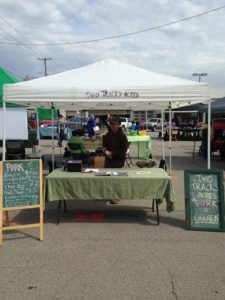 Two Tracks will be at the Saturday Chelsea Farmers Market again, which runs 8 am- 1 pm on Main St in downtown Chelsea. We will also be attending a new market this year – Westside Farmers Market at Zingerman’s Roadhouse. This takes place Thursdays 3-7 pm starting June 2. Come stop on by and visit us!
Two Tracks will be at the Saturday Chelsea Farmers Market again, which runs 8 am- 1 pm on Main St in downtown Chelsea. We will also be attending a new market this year – Westside Farmers Market at Zingerman’s Roadhouse. This takes place Thursdays 3-7 pm starting June 2. Come stop on by and visit us!
Controlled Burn
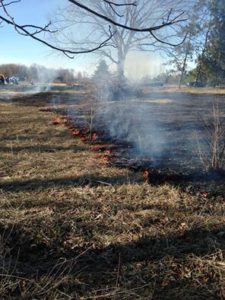 There is a spot next to our house that has been overgrown and ignored for some time, so we decided we needed to burn it. A controlled burn takes a few people to pull off – there should be someone able to reach every side of the area to make sure the fire doesn’t go beyond where it should. You start downwind on one end and light the dry grass on fire, which then makes its way over the entire area, leaving a blank canvass of field behind covered in ash. Our neighbor Ben, Taik and I soaked the edges of the fields with a hose and circled the area, ready with water to put out any rogue flames. But, there was nothing to worry about. We ended up with a cleared area, ready to be planted with whatever we please. I’m thinking buckwheat to crowd out any weeds that come back, for a great food source for the bees, and of course fresh buckwheat pancakes in the fall. Next year I’d like to establish some perennial clover and put some bees in the area.
There is a spot next to our house that has been overgrown and ignored for some time, so we decided we needed to burn it. A controlled burn takes a few people to pull off – there should be someone able to reach every side of the area to make sure the fire doesn’t go beyond where it should. You start downwind on one end and light the dry grass on fire, which then makes its way over the entire area, leaving a blank canvass of field behind covered in ash. Our neighbor Ben, Taik and I soaked the edges of the fields with a hose and circled the area, ready with water to put out any rogue flames. But, there was nothing to worry about. We ended up with a cleared area, ready to be planted with whatever we please. I’m thinking buckwheat to crowd out any weeds that come back, for a great food source for the bees, and of course fresh buckwheat pancakes in the fall. Next year I’d like to establish some perennial clover and put some bees in the area.
Bzzzzzzzz
Speaking of bees, I’ve been tending to some hives with my friend Germaine, a beekeeper in Ann Arbor. She took me out to check her hives this spring to see if any bees had survived the winter. Most hives had died. We pried open the comb and looked at capped honey and bee larvae cells, but no bees. She guessed some had died because of our unusual spring weather. When it warmed up the bees became active and came out from the tight bundle they stay in all winter to keep warm. Then we had another cold snap, which could have killed the bees since they no longer had the body heat of the winter cluster to keep them from freezing.
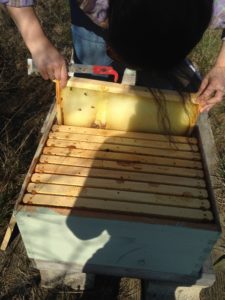 But not all was lost. As we watched the abandoned honey, I saw many native bees from other colonies land on the hives to eat the honey from the abandoned comb. This is a great food source to jump start the colonies that do survive the winter. I would never have recognized the native bee for what it was – they are smaller and blacker than the domestic honey bees most of us keep in our farms and gardens. A hardier breed, they are better adapted to surviving the harsh Michigan winters.
But not all was lost. As we watched the abandoned honey, I saw many native bees from other colonies land on the hives to eat the honey from the abandoned comb. This is a great food source to jump start the colonies that do survive the winter. I would never have recognized the native bee for what it was – they are smaller and blacker than the domestic honey bees most of us keep in our farms and gardens. A hardier breed, they are better adapted to surviving the harsh Michigan winters.
On another note, the city of Chelsea is now considering passing an ordinance to allow people to keep bees in their backyards. They are currently looking at policy from cities that already allow this like Ypsilanti. Hopefully we should see some changes soon, and more pollinators in our area!
Predator in our Midst
We had 100 chickens this spring, but a predator got 40 of them before they were fully grown. We never found out what the predator was, but I suspect a possum because it killed multiple birds at one time, and didn’t eat them all. Now we are extra careful to lock them in at night. Even though they are surrounded by electric netting, a determined animal can still get through.
Automatic Waterer
Work smarter not harder – a motto I wish I lived by more often. But I managed to follow this advice with our new watering system. It’s brilliant – an automatic waterer for both the steers and chickens. A hose fills a barrel with water. Once the water reaches the top, it pushes up on a valve that turns off the hose, so that the barrel automatically refills as the animals drink.
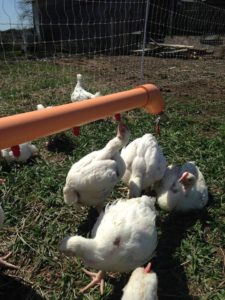 We changed the chickens’ drinking apparatus to a nipple waterer instead of the upside down bucket. This is a pipe that hangs above their heads with nipples all along the bottom. The water fills the pipe and the chickens peck at the nipples to get the water. It took them a minute to figure it out, and we had to put their faces in the water to teach them to peck. But once one got it, the rest caught on quickly. I used to have to haul buckets out to the animals every morning full of water to fill their containers. Now I just make sure it’s working, and the rest takes care of itself.
We changed the chickens’ drinking apparatus to a nipple waterer instead of the upside down bucket. This is a pipe that hangs above their heads with nipples all along the bottom. The water fills the pipe and the chickens peck at the nipples to get the water. It took them a minute to figure it out, and we had to put their faces in the water to teach them to peck. But once one got it, the rest caught on quickly. I used to have to haul buckets out to the animals every morning full of water to fill their containers. Now I just make sure it’s working, and the rest takes care of itself.
Is it a Deer? A Plane? No it’s a…. Pig
The Grange Kitchen and Bar bought one of our pigs for their restaurant, which I delivered in two halves to the front door (their side door was blocked). After helping carry it in, Chef Brandon Johns and I took a trip to check out a garage that had been converted into a kitchen equipped to process deer and animals. The next day Chef Brandon taught a craft butchery class at the converted garage. He showed us all how to break down a whole pig into its parts, and then walked us through the process of making sausage, bacon, and various charcuterie techniques.
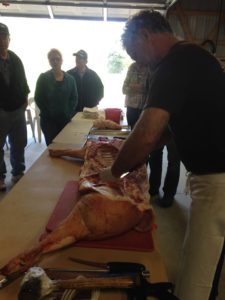 He also told me an interesting story. After I delivered the pig, the Health Department contacted him and said someone had called in a tip that they had seen a person bringing a deer into the restaurant, and were concerned about the food that was being served. So Brandon had to show the inspector that it was in fact legitimate, and a pig. Watch out, you never can tell what those passersby are thinking.
He also told me an interesting story. After I delivered the pig, the Health Department contacted him and said someone had called in a tip that they had seen a person bringing a deer into the restaurant, and were concerned about the food that was being served. So Brandon had to show the inspector that it was in fact legitimate, and a pig. Watch out, you never can tell what those passersby are thinking.
Until next time, be well!
TWO TRACKS ACRES NEWSLETTER – March 2016 (PDF version)
Once again the chicks have arrived, and it’s all cuteness and fluffiness here on the farm. We have 100 of them in the barn, though they’re so small I would not guess there were that many if I didn’t know the exact number. Taik and I also just picked up six baby pigs, a Hereford/Tamworth cross, so cuteness abounds.
Fencing and Paddocks
Although the calves have a nice little paddock to graze and a cozy barn to sleep in we are expanding their area tenfold. Taik and I just got a small loan from the bank to put up fencing around the farm property, and it’s about time! I’ve wanted perimeter fencing for a long while as another measure for keeping in rogue or stray animals. The pigs escaped from their enclosure? At least they won’t make their way into the neighbor’s yard now because we will have that extra fence. The turkeys are headed for the road? No worries, they’ll never make it past our newly erected barrier.
(Above: Me putting in fence posts)
The plan is to put up solid fencing around the perimeter, and further divide the area into paddocks for grazing using electric fence. If we move the calves every couple days, they won’t overgraze and the pasture will grow back more quickly. For now, we’re just letting them roam wherever they want, but if we get more cows the paddocks will be a crucial part of our grazing plan. By the end of this weekend my arms will be sore from pounding in posts.
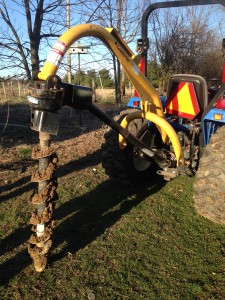 (Above: This post hole digger is much easier than doing it by hand)
(Above: This post hole digger is much easier than doing it by hand)
Old Fashioned Baking
In the spirit of homesteading, I tried my hand at making my own starter for baking sourdough bread. Instead of buying yeast from the store, it’s possible to ‘capture’ the yeast from the air. It’s a matter of fermenting a mixture of flour and water, and the yeast in the air starts to react with the mixture, until you are able to use this as a leavening agent for the bread. My first attempt was unsuccessful and the bread didn’t rise much, but I plan on practicing.
There are two farm to table dinners in Chelsea this summer, and Two Tracks will be donating meat to both. These dinners are becoming more common as the local food movement grows. All of the farmers from market contribute something to the dinner and the menu is planned around what is available. The first one will be at the Chelsea Alehouse on Monday May 9, between 5 and 8. More details will be available on the Chelsea Farmers Market website soon (www.chelseafarmersmkt.org).
CSA
We are still accepting members for the 2016 CSA. Sign up to receive chicken, pork, or a mixture of our products from June through November. Please see our website for details and registration. http://twotracksacres.com/?page_id=11
Until next time, Be Well!!!!
TWO TRACKS ACRES NEWSLETTER – February 2016
(PDF version)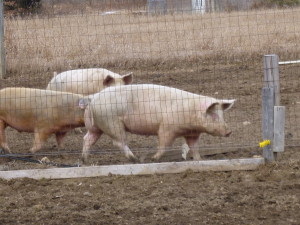
2016 CSA
Two Tracks will be continuing its CSA this summer 2016. We begin in June and run through November. The CSA will be similar to last year, with shares that include pork, chicken, or both. Please see the CSA page for more information and registration details.
GETTING READY FOR SUMMER – EQIPMENT REPAIR
Winter is a time for repairing, planning, and learning. I got a lesson in equipment repair with our neighbor Ben, who invited me to help attach new teeth to the sickle bar mower. This is a scary looking tool, and reminds me of the movie jaws. The toothlike blades slide back and forth to cut the grass for haymaking. Since the old ones were rusted and not very sharp, we replaced them with brand new steel triangles that run all along the blade, like attaching individual teeth on a large saw. This will allow us to cut and harvest a lot more hay this summer.
STEER #2
We’ve acquired a friend for our baby steer Short Round: another calf that follows him everywhere. The two are inseparable. These are Guernsey calves – a breed best for producing milk. Since they are males, it was easy to convince the farmer to sell us the pair because he can’t use them in his milk herd. However, they don’t grow as quickly or have as much muscle as the breeds meant for meat. We are excited to start researching heritage breeds and get some meat cows next time.
IN FOR THE LONG HAUL
I’m becoming better at thinking about the farm in terms of long term planting. We are putting in perennials each year; a luxury we have because we own our land rather than lease it. I wouldn’t want to invest a lot of money in perennials if there was the possibility we’d have to leave it all behind in a few years. This is an obstacle many beginning farmers face these days, with loans difficult to get and high land prices. It limits the products you are able to produce.
We’ve ordered grapes, and are looking into peaches and pears. Spring will tell us if the chestnuts survived the winter, and I’m hoping to put in a few more. We will be tilling the weedy patches on our land and sowing white clover to replace the messiness. Clover is amazing. It smothers out the weeds, adds nutrients and pulls nitrogen into the soil, and can act as a green mulch because it doesn’t grow too high. Once it’s established, I can plant perennials in the clover and not even worry about weeding or mulching. How awesome is that?
I love this time of year because it is full of possibilities, as I imagine the projects and things I want to complete over the upcoming year. Some of my big goals include putting up a large fence for the steers, and dividing it with electric wire into paddocks to improve our grazing plan. Applying for a loan to extend our 5-year land contract to a 30-year mortgage for our farm. Continuing to care for our growing family of what will include this summer: 100 turkeys, many many chickens, 2 calves, 12 pigs (maybe not all at once), 3 cats, a beagle, and of course Taik.
Time to get to work!
TWO TRACKS ACRES NEWSLETTER
September 2015 ((Click here for PDF)
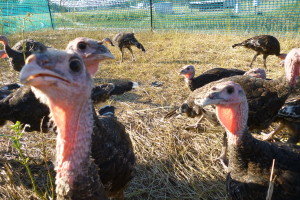 We have turkeys! These bronze breasted birds are escape artists and have thwarted every attempt we’ve made to keep them in their enclosure. They have a large fenced in area but are convinced the grass is greener on the other side, so they escape just about every day. By now Taik has put up fencing two layers tall, adding a new layer after they scaled the old one, but we have yet to find a way to contain them. I know when they’ve gotten out because I can hear their gobbling all around the field, even though I cannot see them in the tall grass.
We have turkeys! These bronze breasted birds are escape artists and have thwarted every attempt we’ve made to keep them in their enclosure. They have a large fenced in area but are convinced the grass is greener on the other side, so they escape just about every day. By now Taik has put up fencing two layers tall, adding a new layer after they scaled the old one, but we have yet to find a way to contain them. I know when they’ve gotten out because I can hear their gobbling all around the field, even though I cannot see them in the tall grass.
So, we are taking orders for Thanksgiving Turkeys! They are $4.50/lb. We estimate they will be between 17 to 25 pounds this year. Let us know if you want to pre order your turkey. Pickup will be a few days before Thanksgiving.
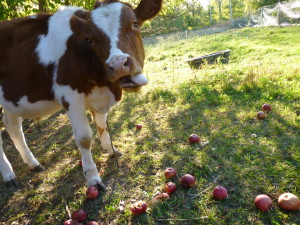 The cow has settled into his home. We’ve given him access to both the barn and field, but he prefers to stay inside away from flies during the heat of the day and come out in the mornings and at night. He expects treats now when we go to the pen, and will run to us when he hears us coming. I’ve been bringing him the fallen apples from our one apple tree, which he loves.
The cow has settled into his home. We’ve given him access to both the barn and field, but he prefers to stay inside away from flies during the heat of the day and come out in the mornings and at night. He expects treats now when we go to the pen, and will run to us when he hears us coming. I’ve been bringing him the fallen apples from our one apple tree, which he loves.
We’ve been able to hay the fields twice this season. It was difficult to get a tractor in this spring because it was so wet. You want a few clear days when haying because it needs to be dry when you bale it. Our neighbor Ben loaned us his tractor (we still don’t have one of our own – it’s on our wish list) and we cut about four acres worth of hay. Then we raked it into long piles, or furrows, and flipped it after the sun had dried the first layer. Only after it had completely dried could we come through with the baler (also borrowed from Ben). My whole family came over to help load the bales onto the truck and into the barn. We’ll use it this winter for bedding and feed for the cow.
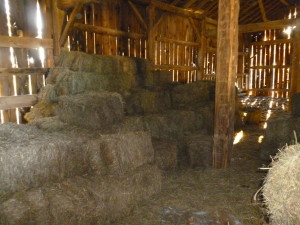 This year was an experiment to see how much hay we can get off of our land, and if it’s enough to support the cow through the winter. How much we use this winter will determine how many cows we’ll be able to have in the future. Being able to produce all of the food the cow needs right here on our own land is a big step toward being sustainable. For our other animals we’ve had to supplement food by buying some from the nearby mill. We are also thinking of planting pasture more suited to grazing so that the animals can get as many nutrients as possible from the space that we have. What we have now is great, but I would like more diversity in the plants which would be healthier for both the land and the animals.
This year was an experiment to see how much hay we can get off of our land, and if it’s enough to support the cow through the winter. How much we use this winter will determine how many cows we’ll be able to have in the future. Being able to produce all of the food the cow needs right here on our own land is a big step toward being sustainable. For our other animals we’ve had to supplement food by buying some from the nearby mill. We are also thinking of planting pasture more suited to grazing so that the animals can get as many nutrients as possible from the space that we have. What we have now is great, but I would like more diversity in the plants which would be healthier for both the land and the animals.
TWO TRACKS ACRES NEWSLETTER
May 2015 (Click here for PDF version)
COWABUNGA
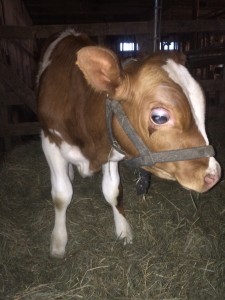 The newest addition to Two Tracks Acres is our first cow, named Short Round. Short Round is a rescue calf who is blind and was having trouble navigating the larger farm where we first met him. Our own space is smaller, and the little guy quickly figured out how to find his way around our barn and fenced in pasture. His cautious exploration of the space was amazing to watch, as he became familiar with the location of the water, the salt lick, his food and the fence by nuzzling about. Short Round is super friendly without being pushy, and will follow us around if we make clicking noises at him. He is a brown and white Guernsey and we are excited to have him.
The newest addition to Two Tracks Acres is our first cow, named Short Round. Short Round is a rescue calf who is blind and was having trouble navigating the larger farm where we first met him. Our own space is smaller, and the little guy quickly figured out how to find his way around our barn and fenced in pasture. His cautious exploration of the space was amazing to watch, as he became familiar with the location of the water, the salt lick, his food and the fence by nuzzling about. Short Round is super friendly without being pushy, and will follow us around if we make clicking noises at him. He is a brown and white Guernsey and we are excited to have him.
CHELSEA MARKET
We’ve started going to Chelsea Market again and it has been very busy so far. In June we expect things to pick up even more when the music and market food assistance token programs, like Double Up Food Bucks, begin. My parents have come to help out a few times, and have made a statement by wearing a unique set of pink pig hats, complete with faces and wings. We tried to make Taik wear them too, but he insisted it would cramp his style. I think the customers really liked them though.
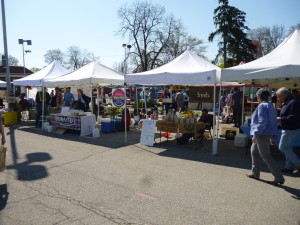 Our garden is alive and well with salad greens, radishes, garlic and more. We are growing mangels this year, a root crop – kind of like a beet – that can get up to two feet long. They are used for feed, and we plan to give them to the pigs this winter.
Our garden is alive and well with salad greens, radishes, garlic and more. We are growing mangels this year, a root crop – kind of like a beet – that can get up to two feet long. They are used for feed, and we plan to give them to the pigs this winter.
CHESTNUT TREES
We have planted eight new chestnut trees. Part of our long term plan for the farm is to grow as many perennials as we can, and this year’s investment was in chestnuts, which were donated to us by MSU extension. If grown from a seedling, they can take about eight years to start producing, but ours were grafted – a chestnut branch attached to an adult root stock – so hopefully they will start producing nuts in 3-4 years. Chestnuts are wind pollinated, rather than pollinated by bees, so we had to be careful to place the pollen producers to the west of the trees that can only receive, and do not produce, the pollen that fertilizes the chestnut flowers. The wind always comes from the west, so we tried to be careful when planning our placement.
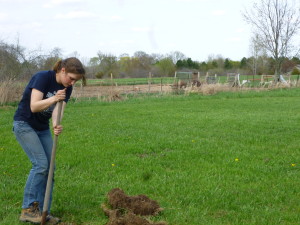 (Above: me digging a hole for the chestnut trees)
(Above: me digging a hole for the chestnut trees)
PICKUP REMINDER – CSA STARTING
Pickup starts the first week of June, Wed 6/3 and Sat 6/6. If you have not yet emailed me your pickup location preference, please let me know soon.
PARTY TIME
Finally, we would like to invite you all out to the farm for a potluck in June! Come see the farm and get to know us better. The potluck will be Saturday afternoon, starting at 5 pm, on June 20. Wear some sturdy shoes so we can walk through the fields and bring a dish to pass around. We are located at:
11845 Orban Rd
Grass Lake MI 49240
Until next time, be well!
TWO TRACKS ACRES NEWSLETTER
March 2015 (Click for PDF version)
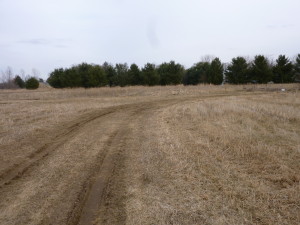 Here we go. I hear the sandhill cranes cackling outside my window and I know it’s time to hit it hard again. Winter has been slow, as usual, and I am eager to get to the longer days and faster pace of summer. We have a couple changes in our routines this year. I am no longer at Capella Farm, but am working part time at Tantre Farm (organic veggies) and as the Chelsea farmers market manager. Taik is working construction, and in the evenings we come home and do what we love best: Two Tracks Acres.
Here we go. I hear the sandhill cranes cackling outside my window and I know it’s time to hit it hard again. Winter has been slow, as usual, and I am eager to get to the longer days and faster pace of summer. We have a couple changes in our routines this year. I am no longer at Capella Farm, but am working part time at Tantre Farm (organic veggies) and as the Chelsea farmers market manager. Taik is working construction, and in the evenings we come home and do what we love best: Two Tracks Acres.
DANGER ON THE ICE
The spring chores are upon us: tilling, pruning fruit trees, seeding peppers, lettuce, kale and collards, and my favorite: cleaning out the chicken coop. We had some trouble this winter watering the animals because the water iced over so quickly. At Tantre, the workers chop a hole in the lake everyday by the cow pasture so that the cows may drink. One evening while we were hacking at the ice, a cow got too close to the hole and slipped, falling straight into the water! The hole we were digging was far out on the lake, so it was too deep for her to get a good footing to push herself out. The cow hung onto the lip of the ice, with her lower half submerged while we scrambled to figure out what to do. I called the owner and he came to the rescue with a sturdy tractor and belt, which we wrapped around her, using the tractor to pull her out. After that episode, we dug the watering hole closer to shore, so if an accident happened again, the cows could just walk out of the shallow water on their own.
WHAT’S NEW WITH FOOD
We have many pigs this spring, which will give us a lot of meat for the summer. I need to order chicks soon, and the egglayers have started cranking out eggs again now that the days are longer. We still don’t have a trailer, so I rely on the goodwill of our fellow, more experienced farmers to help us out with equipment loans. A couple of interesting developments in the food community:
- Tillian, the farm incubator program in Ann Arbor, has more beginning farmers than ever with all kinds of businesses including beekeeping, a salad mix CSA, dried beans, hot peppers destined for the Brinery’s sriracha sauce and many more new and interesting projects.
- The Washtenaw County Food Hub has its community kitchen up and running, and will soon feature a little market with some local products. They’ve acquired more land and want to start investing in perennial habitats such as fruit and nuts.
- Farmers have a new set of food safety regulations to follow in the Food Safety Modernization Act that was just finalized. Although signed into law in 2011, they were still taking comments up until this winter. This is the most sweeping reform in our food safety law in the past 70 years, and focuses on the production (the farmers) side of things.
- Argus Farm Stop, a store that sells local products located on Liberty, in Ann Arbor, is rocking out a new model for selling produce. The store products are kept stocked by the farmers themselves, like a farmers market that’s open all the time. From their website http://www.argusfarmstop.com
Argus provides local producers with a new and different way to sell their products, allowing them to sustain and expand their businesses.
- Products are OWNED AND PRICED by the producer (no brokers or intermediaries allowed) so customers know where their food comes from.
- 80% of the selling price goes back to the producer where it belongs.
- We enable customers to buy from multiple farmers and producers in a single easy transaction.
Check it out if you’re in the neighborhood.
Once again we will be at the Chelsea Farmers Market on Saturdays this summer. Market runs 8am-noon starting May 6. We’ll have chicken, pork, eggs, and a small amount of vegetables in late spring. Pork cuts include breakfast sausage, Italian sausage, ham, pork chops, shoulder roasts, and bacon. The first vegetables of the year will be lettuce, radishes, spinach and salad mix. Everything is all natural – no nitrates or preservatives for the meat, and organic practices for growing veggies.
PICTURES FROM THE FARM
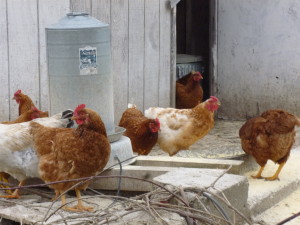 The ladies taking a morning drink
The ladies taking a morning drink
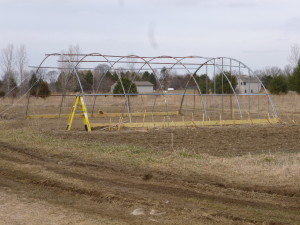 Hoophouse frame – still waiting on the plastic
Hoophouse frame – still waiting on the plastic
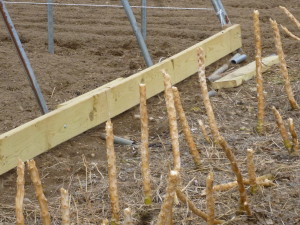 Kale stalks with the heads eaten off by deer
Kale stalks with the heads eaten off by deer
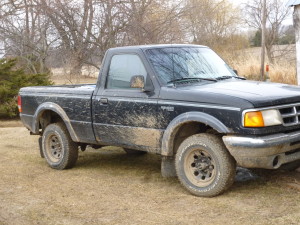 The truck after a trip through the field
The truck after a trip through the field
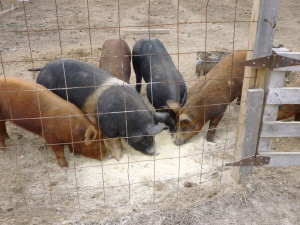 Oops looks like we spilled some feed
Oops looks like we spilled some feed
TWO TRACKS ACRES NEWSLETTER
Oct/Nov 2014 (Click for PDF version)
I’LL HUFF AND I’LL PUFF
I felt like I was in the story of the three little pigs when we began construction of the pigs’ house for the winter. Last year we kept the pigs in the barn and, while warm-ish, it was messy. I ended up cleaning their bedding quite often and it was hard to give them access to the outdoors. That is why this year we are changing tactics and bringing the shelter to them in the field. Taik and I built a straw bale hut in the middle of the pig pen out of the hay we bailed earlier this summer. So they wouldn’t eat it, we wrapped the sides of the hut in fencing, kind of like a fence wall. We filled the inside with more straw so they can snuggle down at night. Just in time too because frost is starting to show in the early mornings.
GARLIC PLANTING
What do the Fourth of July and Halloween have in common? Garlic, of course! Plant by Halloween and harvest by the 4th of July. We started planting just before the end of October. Taik dug trenches with a hoe about four inches deep and placed each clove, pointy side up, in a long line down the trench. As a general rule of thumb, I try to plant seeds twice the depth of their size. So a two inch clove of garlic should be set in a four inch deep trench. We used the garlic we had grown last year as seed. That’s something nice about garlic; the seeds are super easy to save. However, if you are going to plant some yourself, don’t buy it from the grocery store. Buy it from a seed supplier or from the farmers market. In order to clean the cloves, most grocery stores douse them in chemicals and gauge out the dirt around the roots, which also destroys its ability to grow back.
The garlic will sprout up in the Spring and there’s not much to do to it besides harvest in July. However, sometime before July you must pull the scapes – or flower shoots – out of the middle of the plant, or else all the energy will go into the flower and not into the garlic bulb. They are also delicious and have a mild garlic flavor. I am looking forward to next year’s batch.
GOODBYE MARKETS
Sadly, the time has come for the summer farmers markets to close. This year has been great for us at Chelsea and Grass Lake and we are going to produce a lot more next year in order to keep up with demand. If you are like me and simply can’t wait until next year for your markets, check out Dexter, Ypsi, Ann Arbor, and Saline for the winter markets. Remarkably, you can still find greens in the dead of winter from those farms that practice hoop house production.
WINTER IS COMING
Winterizing a farm is a whole production. At Capella Farm, the process is similar to many other small diversified farms in Michigan. We needed to get everything prepared before the major frost set in, otherwise we would lose many of the crops. The ‘shut down’ process includes sealing up the hoophouses for the winter and repairing any tears in the plastic. We covered the crops that are still outdoors (cabbage, rutabaga, turnips, and choi) with row cover – basically a very large blanket to trap the heat. Then we pulled all of the crops that are ready – more turnips, radishes, parsnips – and put them into storage, where we can access them and clean them for market as needed. Then there is the mulching of garlic, leeks, and the remaining parsnips with straw in order to keep them from freezing. These crops will remain in the ground until spring, when we remove the mulch in order to harvest. Leaving them in the ground, rather than in the barn for storage, will keep them fresher.
Don’t forget to come visit us on turkey pickup day starting at 6 pm on Tues, November 25th. This is the last newsletter for a while, so thank you all for your wonderful support this season. We couldn’t have done it without you and we will miss working with you. Until next time, Be Well!
-Stephanie and Taik
TWO TRACKS ACRES NEWSLETTER
August 2014 (Click for PDF version)
The wheat was ready to harvest – the heads were bent over dripping with seeds, and if we left them any longer they would drop and we would lose the crop. Harvest time was now or never, so we asked our friend Ben to bring his combine over. It worked like a dream – for about five minutes. The machine cut the stalks and shook the seeds to separate them in the hopper. It spit the spent shafts out the side. It was wonderful, and then the belt broke.
Without a machine to harvest the wheat, I decided to use a scythe. This was slow work and knocked all the wheat seed to the ground where it got lost in the dirt. Finally I started pulling the stalks up by hand and laying them in piles. It was a hot, humid day and the work was exhausting. I experimented with banging the shafts onto a wooden pallet with a tarp underneath to catch the seeds, but it still felt like I was losing a lot of food. I have used this method to harvest rice while in Thailand and thought it would work similarly, but rice separates from the stalk much more easily than wheat.
With farming, as with many things in life, I’ve found that there is a point when it’s smart to call it quits; when the effort put in outweighs the benefits received. I’ve always been one to press this barrier and keep at a task longer than is practical. Taik took one look at me banging the stalks of wheat against the pallet and told me to call him when I was ready to load it into the barn. He, at least, has a better sense of what’s practical. I just couldn’t stand to watch the food go to waste, even though it would be pretty cheap to buy a similar amount at the grain mill. Sometimes it just feels right to do the impractical.
CALLY’S WEDDING
My sister got married last weekend and we did a “farm to table” dinner for the reception. Two Tracks, Tantre, and Capella Farm provided all of the vegetables for the occasion. Of course we had to plan an in-season menu, so we featured dill potatoes and roasted carrots along with steak or salmon. For a vegetarian option we made fresh sweet corn fritters with arugula and tomato salsa on top. Taik volunteered to cook and a bunch of friends pitched in and helped make it happen. I was stressed the whole time because there were 150 guests but Taik managed to pull it off, somehow. The dinner was delicious and the farm fresh ingredients took it over the top.
SILLY TURKEYS
You may have heard that turkeys can drown when it rains because they look up and forget to close their mouths. Well, the rumors are true. No turkeys drowned per se, but one turkey at Capella Farm (where I work) did get water in its lungs after a thunderstorm because it forgot to close its beak. We asked for suggestions online for a cure and brought it inside the house to warm up. After rubbing Vicks on its nose and raw garlic on its feet (don’t ask, I think garlic is a cure-all) it seemed to perk up. Now I make sure our Two Tracks turkeys are in their pen when I know a storm is coming.
Thanks and Be Well!
TWO TRACKS ACRES NEWSLETTER
July 2014 (Click for PDF version)
Turkeys
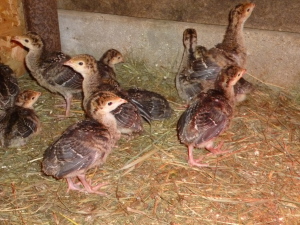 I got a call from the post office that the turkeys had arrived. In the background I could hear the chirping of forty chicks complaining about being cooped up in a box for two days. I told Taik to rush over and get them situated in their spot in the barn. We had gone to a lot of trouble to set up the turkey area in preparation for their arrival. The difficult thing about turkeys is that they cannot come into contact with chickens, or even be in a place where chickens used to be, when they are young because they are susceptible to catching a disease called “blackhead” from chickens. We have a space set up specifically to house chicks, so we hosed it down and spread lime over the entire spot, to help cleanse the area. We were extra careful with our cleaning so as not to endanger the turkeys with chicken residue. I am happy to report that so far they are all very healthy and growing quickly.
I got a call from the post office that the turkeys had arrived. In the background I could hear the chirping of forty chicks complaining about being cooped up in a box for two days. I told Taik to rush over and get them situated in their spot in the barn. We had gone to a lot of trouble to set up the turkey area in preparation for their arrival. The difficult thing about turkeys is that they cannot come into contact with chickens, or even be in a place where chickens used to be, when they are young because they are susceptible to catching a disease called “blackhead” from chickens. We have a space set up specifically to house chicks, so we hosed it down and spread lime over the entire spot, to help cleanse the area. We were extra careful with our cleaning so as not to endanger the turkeys with chicken residue. I am happy to report that so far they are all very healthy and growing quickly.
We have forty turkeys that we will be raising for Thanksgiving. If you are interested in a fresh Thanksgiving turkey let us know.
New Coop and Ducking Chickens
Our egglayers used to have free reign over the backyard, strutting around anyplace they pleased, which usually included waiting by the front door and leaving chicken droppings for us to step on. In addition, they were wandering further and further afield, until I routinely found them down the driveway next to the road. It was getting out of hand, so we decided enough was enough and built them a new fenced in area. The area is still very large, but it ensures that they are kept separate from the house, the garden, and the road.
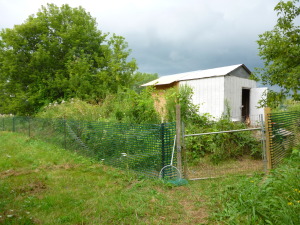 Unfortunately, two chickens don’t seem to get the message. They have discovered a way out (I still don’t know how) and escape from the fence every day only to return in the morning for a bit of breakfast with the rest of the flock. Taik believes that the rogue chickens are suspicious of our intentions to catch them because he sees them duck every time he passes by. I wish they would take a cue from the duck, which is quite happily living among the rest of the chickens as a member of the flock.
Unfortunately, two chickens don’t seem to get the message. They have discovered a way out (I still don’t know how) and escape from the fence every day only to return in the morning for a bit of breakfast with the rest of the flock. Taik believes that the rogue chickens are suspicious of our intentions to catch them because he sees them duck every time he passes by. I wish they would take a cue from the duck, which is quite happily living among the rest of the chickens as a member of the flock.
We are still looking for pigs. I mentioned in an earlier newsletter that a virus has hit many pigs across the country and they are much scarcer than they were last year. The porcine epidemic diarrhea virus has an almost 100% mortality rate for young piglets and has killed over 7 million piglets in the past year. Prices for young feeder pigs have tripled. The last people we got our pigs from said they had customers coming from all over the state – Grand Rapids, Lansing, Jackson – just for pigs from that litter. This development has made us seriously consider breeding our own.
The pigs we do have are troublemakers. A few weeks ago the large ones got out from the fenced in area where we keep them. Panicked, we followed the trail of destruction into the neighbor’s yard. There they sat contentedly rooting up his lawn. We tried to herd them and push them back home until our neighbor noticed us and came outside to help. He had a trailer but it was too high, and pigs are very wary of ramps. We eventually ended up building a pig “sled” with sides and a curved piece of plywood for the floor. I ushered them inside, and we dragged the whole contraption back to the pen.
The pigs have a certain way of greeting us by snorting and galloping about whenever we draw near. We recently combined two generations of pigs, and Taik believes that the elder one has taken the young’uns under its wing. Whenever he approaches, the little ones run to the back of the enclosure while the big pig swaggers toward him, not exactly aggressive but definitely in an attempt to intimidate (which it does rather successfully).
Preserving
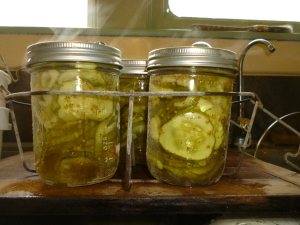 The height of summer yields an abundance of food. We have more beans, peppers, and peas than we know what to do with. Taik and I have spent a few afternoons in a hot kitchen blanching and freezing vegetables to store up for the winter. Don’t forget to take some time to preserve while food is plentiful!
The height of summer yields an abundance of food. We have more beans, peppers, and peas than we know what to do with. Taik and I have spent a few afternoons in a hot kitchen blanching and freezing vegetables to store up for the winter. Don’t forget to take some time to preserve while food is plentiful!
TWO TRACKS ACRES NEWSLETTER
June 2014 (click for PDF version)
Haymaking
We need hay for bedding, and we have acres of field that can be used for haying on our property. The only thing we don’t have is a hay baler, or a sickle bar mower. These tools essentially cut and bale the hay when you pull them along the field with your tractor. I was determined to get this hay, so I decided that I would use a scythe if I had to. After about an hour of this and little progress, I gave up and we called our neighbor, Ben, for some help.
Ben brought over his tractor, a brush hog, and some trusty tools. When we bought the property, we inherited an old hay rake from the 1930’s. We tinkered with it and got it up and running. This machine combs through the cut field and pushes the straw into long lines, or windrows. Then we let the sun bake it for a day, and ran the machine through again in order to turn the hay over and dry the other side. If straw is not completely dry when stored, the decomposition can heat it up so much that it catches fire. Many barns have burned down this way.
The final step was to drive our truck into the field and load the hay onto the back with our pitchforks. We then unloaded it into the barn, hacking and coughing as straw flew through the air. I wasn’t sure how much we would get out of this endeavor, but just a fourth of the filed yielded enough for the winter. This, of course, means that next year we can get some cows! If we have enough to feed them through the summer and winter (which, we learned, we do), then bring it on.
Invasion of the Potato Beetle
It is the year of the potato beetle. It seems like every year has its particular pest, and this year the Colorado potato beetle has descended in full force upon our potatoes. It is an ugly, squishy red bug that eats the leaves of the potato plant and decimates it before it can finish growing the potatoes. Since we grow organically, we have to pick them off by hand. Every few days we comb through the potatoes and brush the icky things off into cups filled with soapy water (to stop them from crawling out). So far, we seem to be winning the battle.
New Extern
Two Tracks has an extern this summer. She learned about us through a program at Kalamazoo College (where I studied) that links students with alumni.
Being at Two Tracks has been quite an experience so far! Upon arrival, I was greeted by a fleet of chickens, wandering around the yard as if they too operated the farm. After taking a tour (often accompanied by either a cat or chicken), I knew that these next few weeks were going to be exciting. I decided to do my internship on a farm instead of in a hospital, political campaign, or law office because of my interest in just, local, and sustainable food systems. At K College, I am involved in a student organization that strives to connect students with food grown locally and sustainably. Through my work with that organization, I have come to the conclusion that I would like to pursue a career in food systems. I then decided that having farm experience would not only give me essential knowledge on sustainable agriculture, but the opportunity to see if farming was the way in which I would involve myself in sustainable food systems. Being on Two Tracks is allowing me to see two sides of sustainable agriculture: produce and meat production. In the upcoming weeks, I’m looking forward to spending more time at Two Tracks as well as interacting with other community members involved in different facets of food production! – Greta Herrin
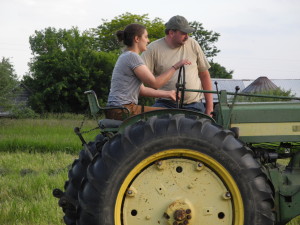 (Above: Greta doing tractor training)
(Above: Greta doing tractor training)
Market
Chelsea and Grass Lake markets are going strong this year. Taik has been a market rockstar and we are nearly out of pork already, although we are due to get some more next week. The Grass Lake Diner – an excellent place to check out for breakfast/lunch if you haven’t already – has also been purchasing some vegetables from the farm. Hope to see some of you there!
Thanks and Be Well!
TWO TRACKS ACRES NEWSLETTER
April 2014 (Click for PDF version)
Spring is in the air. The chicks are peeping, the plants are sprouting, and I just got my first mosquito bite. Ahhh Spring.
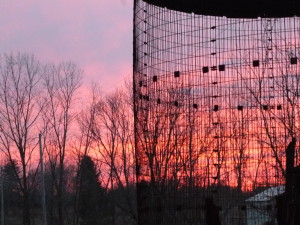 Welcome old and new members to Two Tracks Acres 2014! We are looking forward to selling Two Tracks meat and maybe some veggies at the Grass Lake and Chelsea markets this summer. This is the next step in diversifying our farm, and we can’t wait to get out to some markets.
Welcome old and new members to Two Tracks Acres 2014! We are looking forward to selling Two Tracks meat and maybe some veggies at the Grass Lake and Chelsea markets this summer. This is the next step in diversifying our farm, and we can’t wait to get out to some markets.
This winter was a difficult one and we are getting off to a slow start. We were finally able to move both the chicks and pigs to the outdoors since it’s become warmer, but let me tell you it was none too soon. The pigs have a new fenced in enclosure from last year. We rotated their pen and spread a cover crop over the old area, which should grow well on such fertile ground. Pigs have had a hard time of it this winter because there is a virus going around and farmers have lost many of their animals due to cold and disease. Two of our regular sources for piglets did not have any available (I think mostly because they lost litters to the cold) but it is a problem all over the country. Fortunately we got lucky and eventually found some, so we are ready to go.
A few weeks ago a “box o’ chicks” arrived for us at the post office. This is how they deliver chicks these days – in the mail. Surprisingly, they were none the worse for wear and were simply very hungry. We have also found a new source of non GMO corn for the chickens. This is exactly what we were hoping for, and although we won’t be able to start getting it until later in the season, we are eager to switch over to a product more in line with our values.
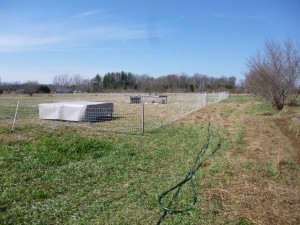 |
We have been working on the “homestead” and have added fruit trees, a vegetable garden, and a hoop house. Progress is good.
This year the season will begin the last Wednesday in May (May 28th) and Saturday (May 31). Please email your preference for pickup:
(1) Wednesday Food Hub evening
(2) Wednesday Tantre Farm afternoon
(3) Saturday Food Hub morning
I will soon send specific times when a volunteer (or ourselves) will be available at the pickup places to greet you.
If you are interested in a once a month pickup – getting all your shares for the month at one time – please let us know as this option is also available.
If you have not made your final payment, please send it soon before the season starts.
Thanks and Be Well!
TWO TRACKS ACRES NEWSLETTER
November 2013 (Click for PDF version)
So we’ve finally come to the end of the season. It has certainly been an adventure, beginning to learn how to run this farm of ours. The year started with us cleaning out the hay and manure from the old cow barn. Swept it away into a compost pile. Now we have a clear space to put the animals in the winter. The barn used to house dairy cattle, so the troughs and stalls are still there. We converted one into a place for chicks, with some heat lamps and a wire mesh top to keep out predators. We hope to turn the old milk room into a processing area, with a sink and oven for heating water.
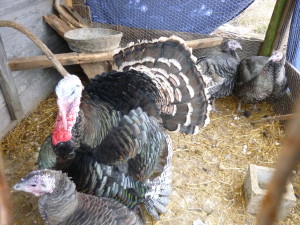 This year we also tilled a part of the land to plant feed for next year’s animals. We planted some winter wheat and will be planting corn next year. Since it’s so hard to buy organic feed, we believe growing our own feed will be healthier and more sustainable to our operation. Next year is an experiment to see how much we will need to plant in order to feed the animals we have.
This year we also tilled a part of the land to plant feed for next year’s animals. We planted some winter wheat and will be planting corn next year. Since it’s so hard to buy organic feed, we believe growing our own feed will be healthier and more sustainable to our operation. Next year is an experiment to see how much we will need to plant in order to feed the animals we have.
The rest of the land remains in pasture, which the chickens and turkeys enjoyed and the pigs are still pleased to have. Our barn roof needs mending and the house needs a lot of work, but isn’t that how it always is? This first year has been about getting to know this place, and next will be about improving and building.
We raised a few turkeys this year as an experiment. The largest was a 33 pound birdzilla of a turkey. Next year we want to raise more but will probably try a different breed or get them later in the year, so they won’t get as big.
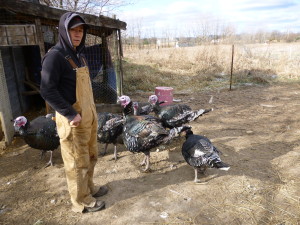 A few friends came over to help us butcher and pluck them before Thanksgiving. The birds were so big that we needed two people to pick them up, and four people to pluck. Even with all the help, it still took us ten hours to do seven birds. (To put into perspective, it takes about a half hour to do a chicken.) The turkey on our Thanksgiving table was delicious, but I will miss them strutting around, feathers fluffed up, and their happy sounding gobbling.
A few friends came over to help us butcher and pluck them before Thanksgiving. The birds were so big that we needed two people to pick them up, and four people to pluck. Even with all the help, it still took us ten hours to do seven birds. (To put into perspective, it takes about a half hour to do a chicken.) The turkey on our Thanksgiving table was delicious, but I will miss them strutting around, feathers fluffed up, and their happy sounding gobbling.
We had hoped to go to the farmers market this year to sell meat, but we never made it because we didn’t have enough product to sell. Next year, it is our goal to raise enough meat to sell at one of the markets in the area.
We will be doing the CSA again next year, but we still need to figure out details. This year has been great and it has been wonderful working with all of you. Thank you so much! We will be in touch, and in the meantime, happy holidays.
Until next time,
Be well!
TWO TRACKS ACRES NEWSLETTER
TILLING
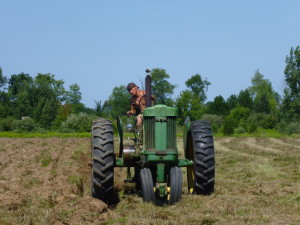 Believe it or not, it’s already time to start thinking about next year. What was once a hay field behind our house has been plowed and tilled so that it can be planted. Much of our land remains in pasture, but it is strange to look out the window and see soil where tall grass used to be. I had mixed feelings as I watched the tractor overturning huge swathes of soil; even though I am excited to plant, it feels strange that we are changing the landscape so drastically. In the newly tilled land, we will plant organic wheat for animal feed and for grinding into flour to make bread next year. At first I was worried about the plowing. After all, wasn’t the mouldboard plow largely responsible for the dustbowl? I learned that yes, plowing can be bad if done each year for a number of years. The heavy weight of the tractor, the overturning of the soil and disturbance of the topsoil, can cause the ground to become too compact beneath the first few feet in an effect known as hardpan. As most growers know, it is very difficult to grow plants in soil that is overly compacted because roots cannot break through, microorganisms are destroyed, and erosion can occur. However, plowing only once every few years and a good crop rotation including green manure and biomass can avoid most of these problems. Roots from cover crops that act as green manure can reach deep into the soil and loosen the dirt, while bringing nutrients toward the surface. They also add to the soil health when tilled under because they decompose into food for the next plants. Of course, there is always an argument for not tilling at all, a technique I hope to research further. For now, November first is our start date for sowing winter wheat.
Believe it or not, it’s already time to start thinking about next year. What was once a hay field behind our house has been plowed and tilled so that it can be planted. Much of our land remains in pasture, but it is strange to look out the window and see soil where tall grass used to be. I had mixed feelings as I watched the tractor overturning huge swathes of soil; even though I am excited to plant, it feels strange that we are changing the landscape so drastically. In the newly tilled land, we will plant organic wheat for animal feed and for grinding into flour to make bread next year. At first I was worried about the plowing. After all, wasn’t the mouldboard plow largely responsible for the dustbowl? I learned that yes, plowing can be bad if done each year for a number of years. The heavy weight of the tractor, the overturning of the soil and disturbance of the topsoil, can cause the ground to become too compact beneath the first few feet in an effect known as hardpan. As most growers know, it is very difficult to grow plants in soil that is overly compacted because roots cannot break through, microorganisms are destroyed, and erosion can occur. However, plowing only once every few years and a good crop rotation including green manure and biomass can avoid most of these problems. Roots from cover crops that act as green manure can reach deep into the soil and loosen the dirt, while bringing nutrients toward the surface. They also add to the soil health when tilled under because they decompose into food for the next plants. Of course, there is always an argument for not tilling at all, a technique I hope to research further. For now, November first is our start date for sowing winter wheat.
TEAM MAMA
How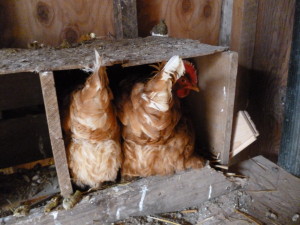 does a chicken hatch an egg? By teaming up with another chicken, of course! I mentioned in an earlier newsletter how Broody, one of our egg layers, was trying to hatch eggs with little success. I guess she solved that problem, because one day I walked into the coop and there were two chickens sitting together on the same nest. They tag teamed the incubating job for the required 21 days and voila, we have two baby chicks to show for it. Yay mamas.
does a chicken hatch an egg? By teaming up with another chicken, of course! I mentioned in an earlier newsletter how Broody, one of our egg layers, was trying to hatch eggs with little success. I guess she solved that problem, because one day I walked into the coop and there were two chickens sitting together on the same nest. They tag teamed the incubating job for the required 21 days and voila, we have two baby chicks to show for it. Yay mamas.
FARMING CERTIFICATIONS: A BREAKDOWN
Maybe you have heard of some of these labels: Organic, GAP, MAEP, FSMA. These random letters are common in farming lingo. They represent different types of certification for farms, implying different production practices. But for those who don’t farm for a living, it can be hard to know how farms operate just based on these labels, without a little more information.
You have of course heard of Organic certification. An organic label is hard to attain, and rightly so. Organic practices must be followed strictly, with tracking and documents to prove that the only pesticides and fertilizers used are organic ones (much healthier compounds which quickly erode), that seeds are organic, and so on. You have probably also heard of mega farms that are organic, challenging us to define exactly what types of farming we support. Is organic sustainable if it applies to monocropping? And how about wise uses of water, soil, etc. That is why I encourage everyone to speak with their farmer or even visit farms in order to understand which practices their grower uses.
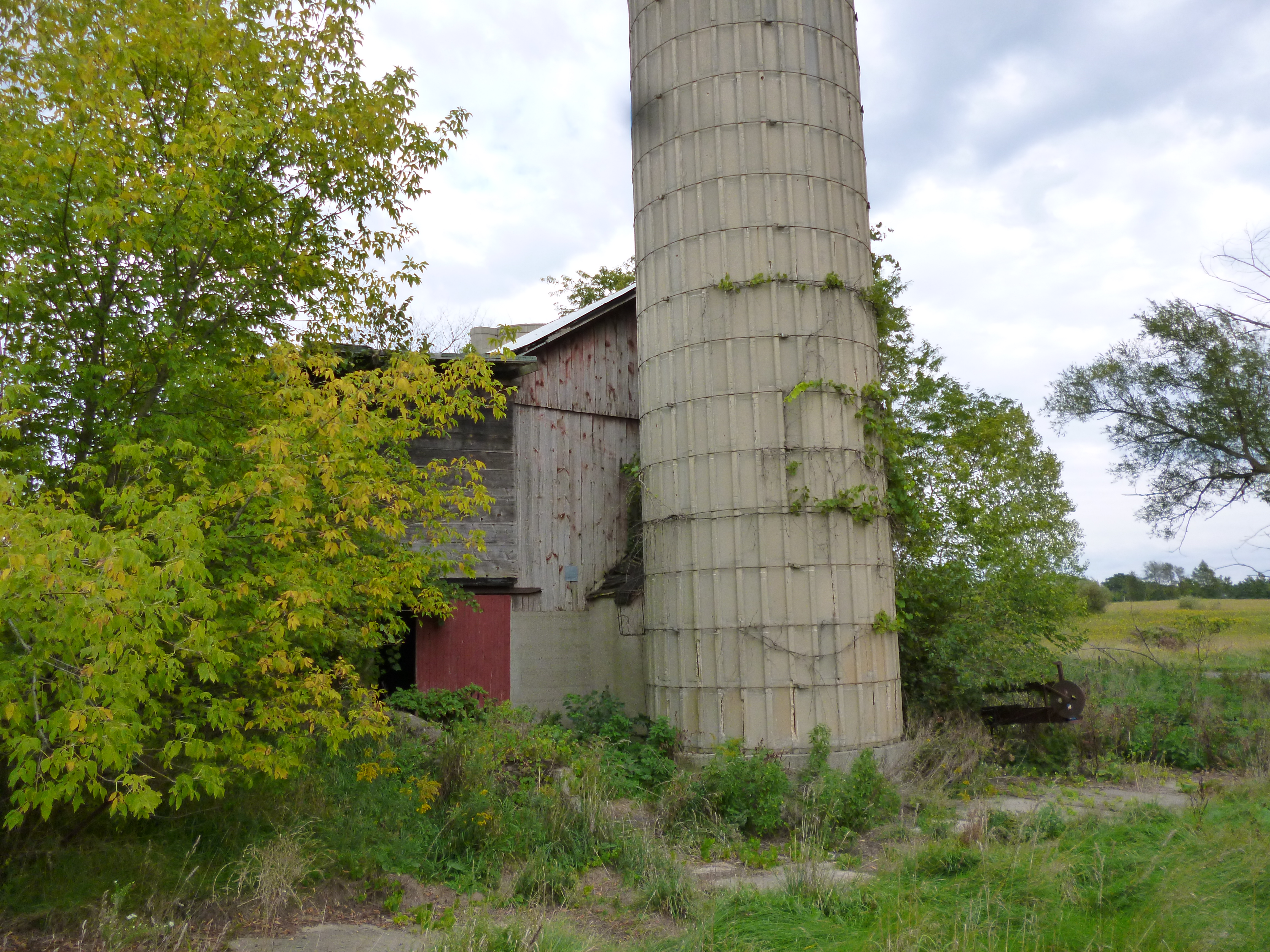 Some newer acronyms have entered the producer’s world within the past few years. GAP, or Good Agricultural Practices, is a voluntary certification that a farm can obtain which is considered one of the safest ways of growing and harvesting food. And, ok, I’ll just say it – I don’t like the GAP requirements at all. Most large institutions that order food such as Walmart, Meijers, U of M, etc, require a farm to be GAP certified before they will buy its produce. GAP guarantees that food is ‘super clean’ by keeping possible contaminants as separate from the food as is possible while in the field. Wildlife contact (including birds) with the produce must be controlled. All containers must be sanitized daily. The emphasis is on eliminating the bacteria and bad microbes that could cause disease. I have a few problems with this. The separation of farming from nature does not encourage a diverse ecosystem, but rather calls for the farmer to exercise even tighter control over the environment, essentially creating more work for the farmer and requiring greater artificial inputs to make up for the lack of natural diversity. Without a lot of biodiversity, soil – the heart and soul of a farm – is not alive. It requires microbes, bacteria, fungi, insects, and all manner of things to be healthy. Secondly, the record keeping required and the cost of implementing such a system are extremely expensive. Thus, small farms lose access to this market – even if they were able to meet the demands of quantity.
Some newer acronyms have entered the producer’s world within the past few years. GAP, or Good Agricultural Practices, is a voluntary certification that a farm can obtain which is considered one of the safest ways of growing and harvesting food. And, ok, I’ll just say it – I don’t like the GAP requirements at all. Most large institutions that order food such as Walmart, Meijers, U of M, etc, require a farm to be GAP certified before they will buy its produce. GAP guarantees that food is ‘super clean’ by keeping possible contaminants as separate from the food as is possible while in the field. Wildlife contact (including birds) with the produce must be controlled. All containers must be sanitized daily. The emphasis is on eliminating the bacteria and bad microbes that could cause disease. I have a few problems with this. The separation of farming from nature does not encourage a diverse ecosystem, but rather calls for the farmer to exercise even tighter control over the environment, essentially creating more work for the farmer and requiring greater artificial inputs to make up for the lack of natural diversity. Without a lot of biodiversity, soil – the heart and soul of a farm – is not alive. It requires microbes, bacteria, fungi, insects, and all manner of things to be healthy. Secondly, the record keeping required and the cost of implementing such a system are extremely expensive. Thus, small farms lose access to this market – even if they were able to meet the demands of quantity.
Another voluntary certification is MAEAP (Michigan Agriculture Environmental Assurance Program), which is much more accessible. It still requires a good deal of record keeping, but focuses on sustainable and environmental safeguards without being unreasonable. This includes tracking the following: crop rotation; application of water, fertilizers and pesticides; and soil quality. The CSA coalition, a group of CSAs working together in Ann Arbor, has adopted this as a baseline certification for their farms. It guarantees customers that their food is grown responsibly. Also, the coalition hopes to approach some key health insurance companies about offering membership rebates for those insurance members who join CSAs. The insurance companies cut down on costs by encouraging people to eat healthier, the CSA is more affordable for participants, and more food is bought locally. We are waiting to see how this project works and if the insurance companies are willing to accept MAEAP certification as an adequate food safety guideline.
Finally, FSMA, or the Food Safety Modernization Act, is a new set of regulations being required of all vegetable farms that gross over $500,000. In the past, there were no such laws monitoring growers. Unfortunately, the FSMA program tends to fall along the same lines as GAP in its requirements, while a little less strict. Public input is still being accepted at this time before the bill is passed.
I am not against government oversight of food production. The question I would like to raise is how far should the oversight go? Can the economy be self-regulating, with irresponsible farmers going out of business, or does the government need to protect us further? Also, do these regulations (GAP, FSMA) take us in the right direction for how we want our farming systems to operate, with cleanliness gained at the expense of biodiversity?
Thanks and be well!
TWO TRACKS ACRES NEWSLETTER
August 2013 (PDF version)
DUCKS NOW AVAILABLE
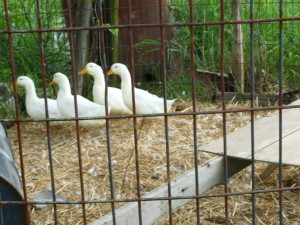 We have duck available! Finally, after weeks of being kept awake from all the quacking (ducks are very skittish), the ducks are ready for eating. If you would like one, please email me and I can deliver it with the rest of your share. They are 2-3 pounds (on the small side) and cost $20 per duck. Also, we sold some to the Grange in Ann Arbor – our first restaurant sale! – and the chef will be preparing them soon as a dinner special. I don’t yet know what dish he is planning, but I’ll let you know when I find out.
We have duck available! Finally, after weeks of being kept awake from all the quacking (ducks are very skittish), the ducks are ready for eating. If you would like one, please email me and I can deliver it with the rest of your share. They are 2-3 pounds (on the small side) and cost $20 per duck. Also, we sold some to the Grange in Ann Arbor – our first restaurant sale! – and the chef will be preparing them soon as a dinner special. I don’t yet know what dish he is planning, but I’ll let you know when I find out.
IDEAS FOR GROUND PORK
Those of you who receive pork have been getting a lot of ground pork in the share. I would like to suggest making it into sausage. Don’t be intimidated, it’s extremely easy. The easiest recipe, and one of my favorites, is a simple breakfast sausage with sage, salt and pepper. To take it over the top, throw in some fennel seeds. For those of you that like a little spice, try a chorizo recipe. I have included one for which I have had great success at the end of the newsletter.
EXTRA EGGS
The chickens have been busy and we have an overabundance of eggs at the moment. I will be leaving a few cartons at the food hub during pickup time for anyone to take. The cost is $3/dozen and we will have an egg money jar next to them for the deposits. Eggs are for one and all so get there early if you want some!
OUT WITH THE OLD
The farm underwent some major cleaning as we ditched the previous inhabitants’ junk (lots of porcelain bunnies) and made way for Two Tracks Acres junk (a lot of porcelain pigs). My mom, horrified by the state of the barn and the garages, insisted we order a dumpster and dedicated her and my dad’s weekend to helping us fill it. Now the place is spick and span and feels much more like ours, rather than someplace we are renting, with another person’s things filling up the spaces.
There are two fruit trees in our yard and while we were cleaning, the apple tree branch decided it couldn’t bear its burden of fruit any longer and snapped. The limb crashed down to rain apples all over the yard. We scooped them up, put them in the loader bucket, and fed most of them to the pigs. Since the apples weren’t ripe, we kept only a few to experiment with cider recipes. If anyone knows any, please tell!
THE CAT WHO THOUGHT IT WAS A CHICKEN
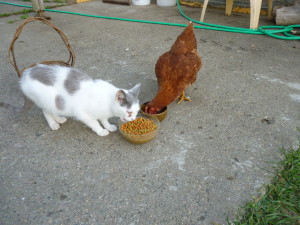 A new addition to the farm has joined us. For a time, Taik thought that our orange cat, Cattywompus, was extremely fast. One moment it would be by the garden, the next we would see it on the other side of the farm by the barn. Until we realized there was actually another orange kitten that had moved in. This newcomer is strange and I think it believes it is a chicken. I have often found it sleeping in the hen house at night, among the roosting chickens, and so far it only hangs out with the flock. With luck, I will be able to convince it to come to the house.
A new addition to the farm has joined us. For a time, Taik thought that our orange cat, Cattywompus, was extremely fast. One moment it would be by the garden, the next we would see it on the other side of the farm by the barn. Until we realized there was actually another orange kitten that had moved in. This newcomer is strange and I think it believes it is a chicken. I have often found it sleeping in the hen house at night, among the roosting chickens, and so far it only hangs out with the flock. With luck, I will be able to convince it to come to the house.
CHORIZO RECIPE
Ingredients:
1 ½ teaspoons fennel seeds
½ teaspoon salt
1 pound 2 ounces ground pork
2 teaspoons hot smoked paprika – pimenton (I used a mix of regular paprika and crushed dried chili peppers, and it still tasted good)
2 garlic cloves, crushed
1 tablespoon red wine vinegar
Pepper
Grind the salt and fennel together until fine. Put the pork in a large bowl and add the fennel, salt, paprika, garlic and vinegar. Mix together, and check the seasoning by frying a small amount in a pan to taste. Add more salt, paprika, or pepper if needed.
Older Newsletters (click to follow link)
March 2012, April 2012, May 2012, June 2012, July 2012, August 2012, September 2012, October 2012



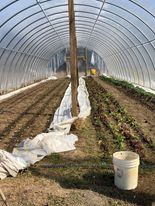
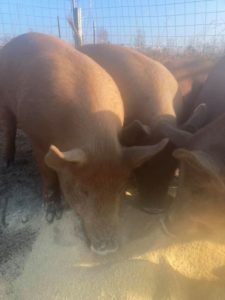
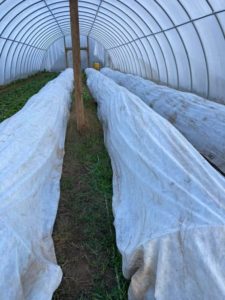

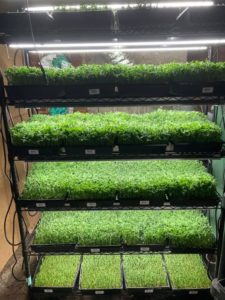
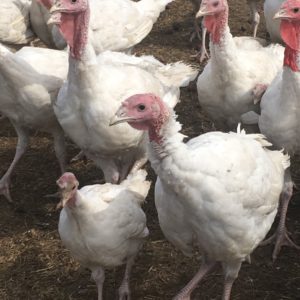
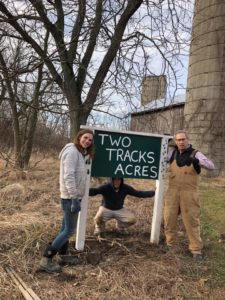

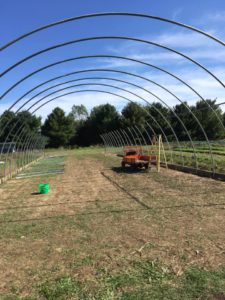
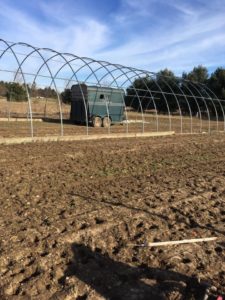
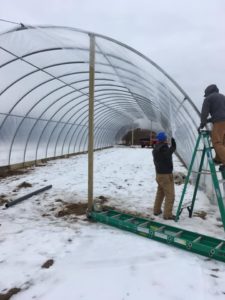
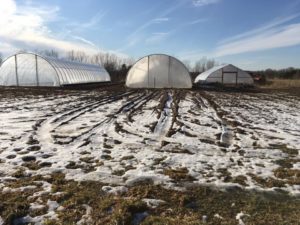
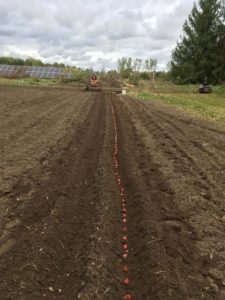 (above: planting tulip bulbs)
(above: planting tulip bulbs)